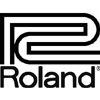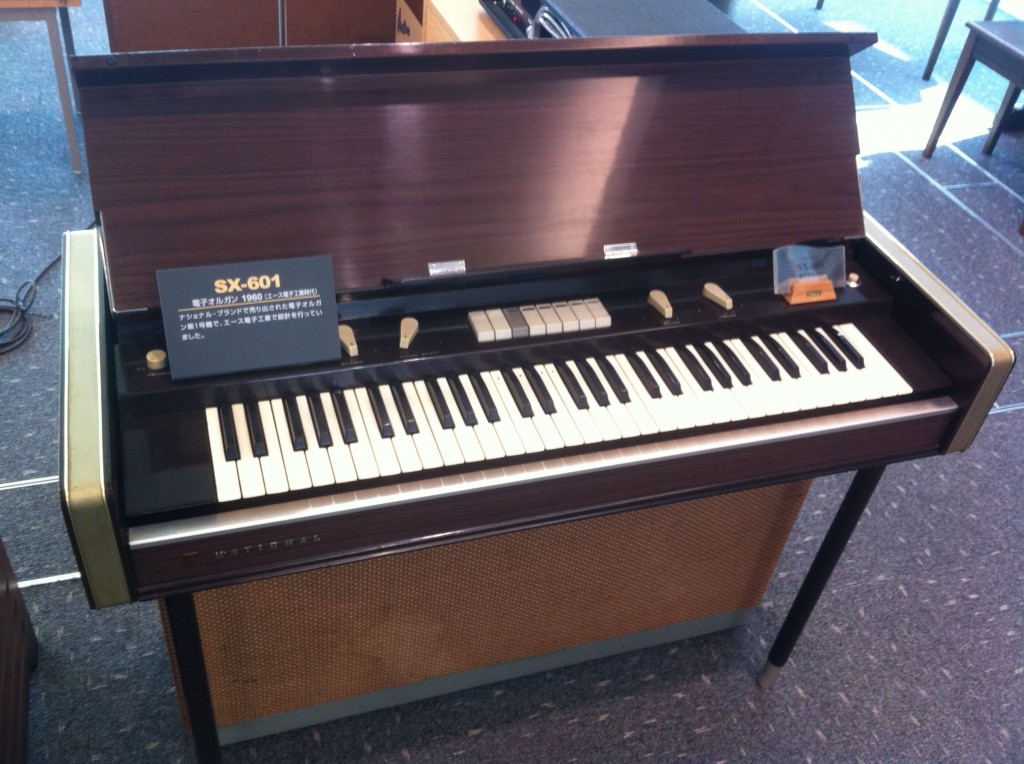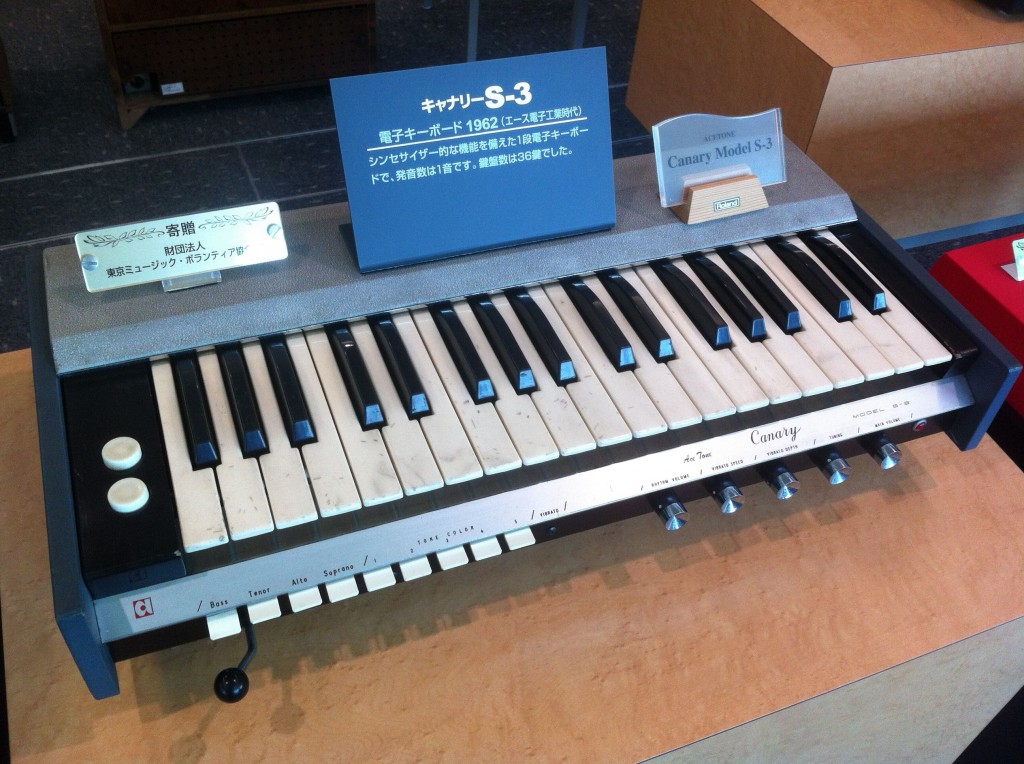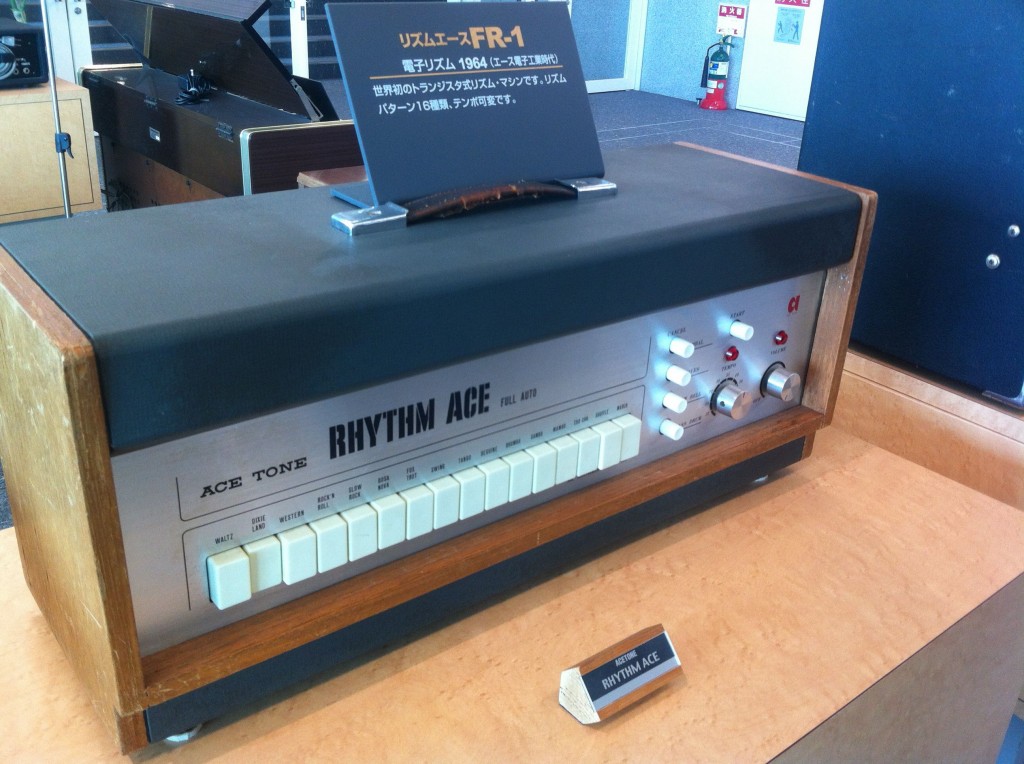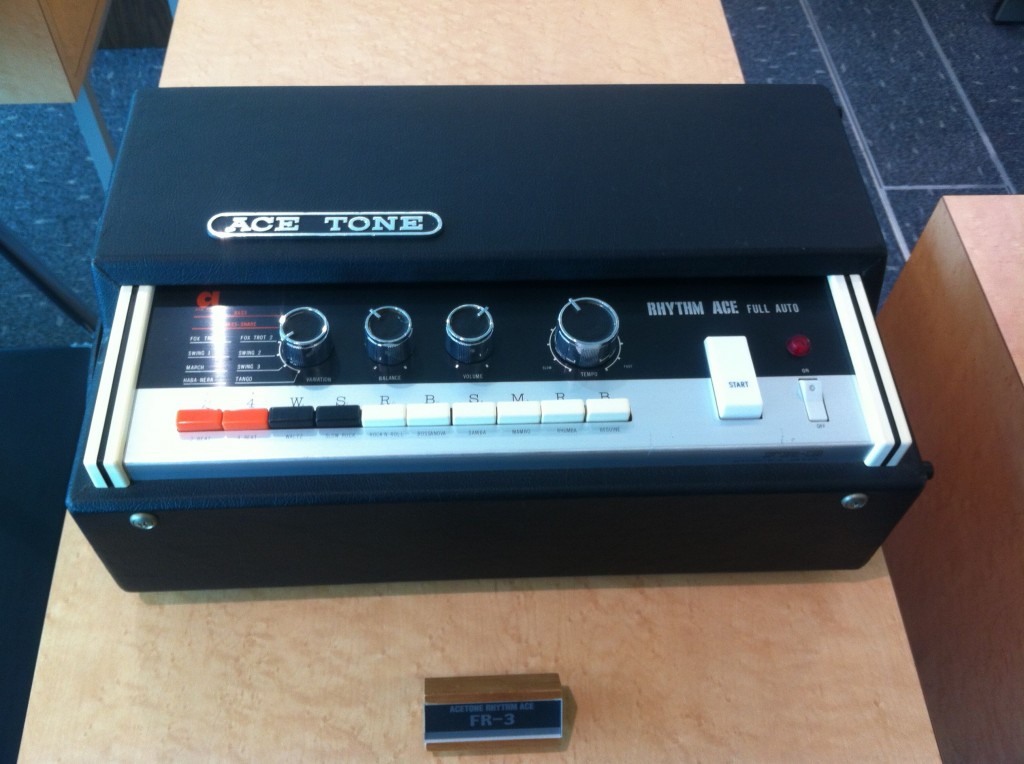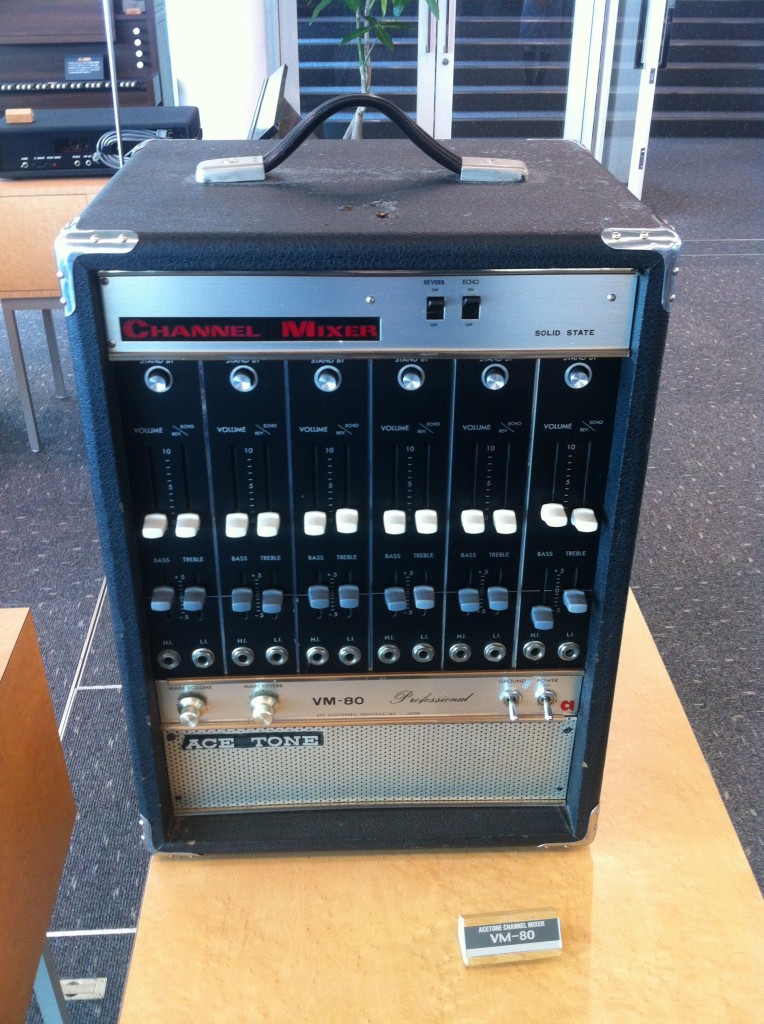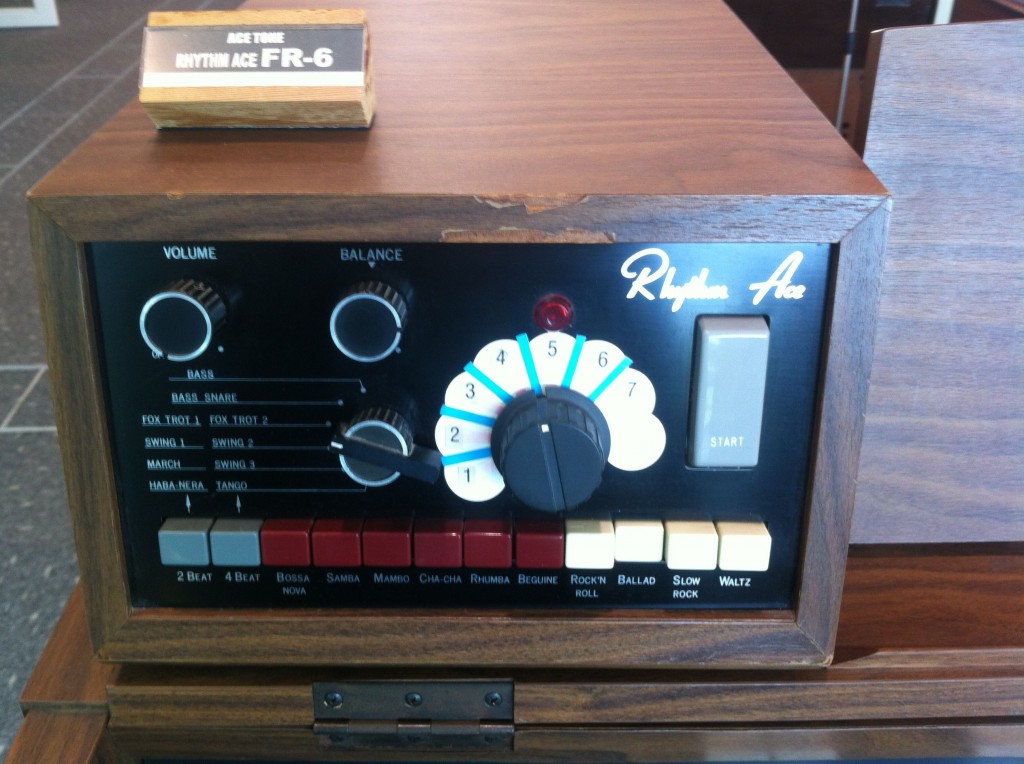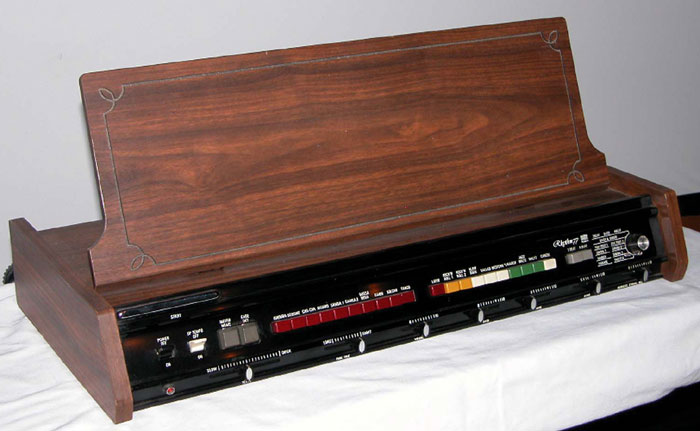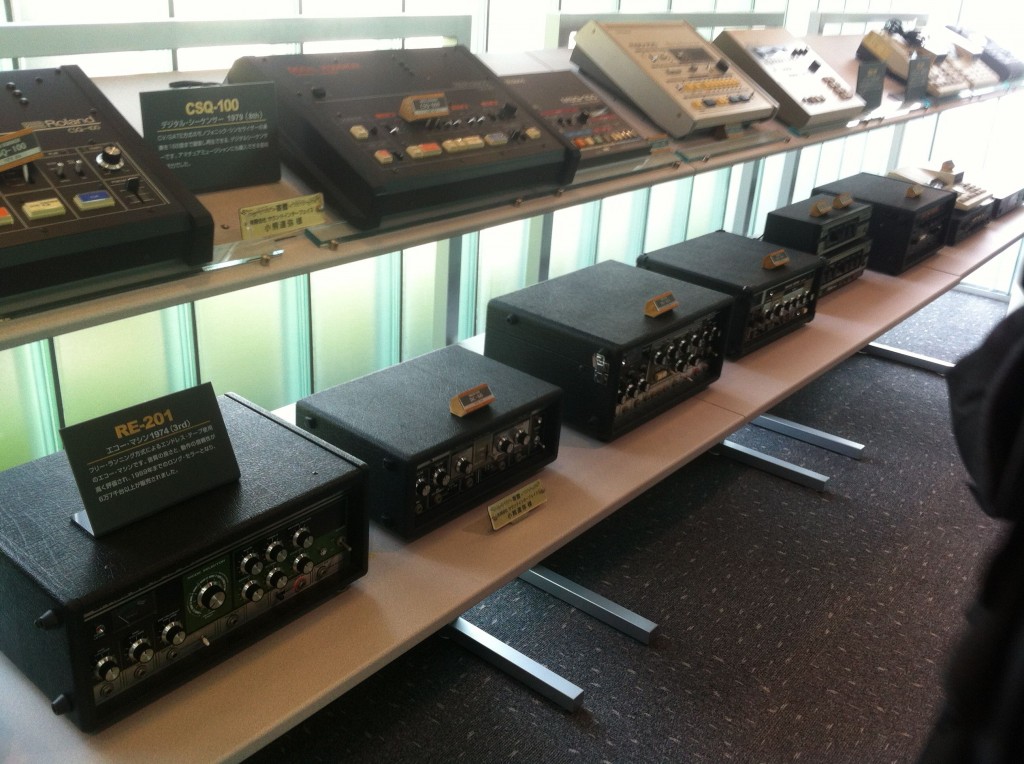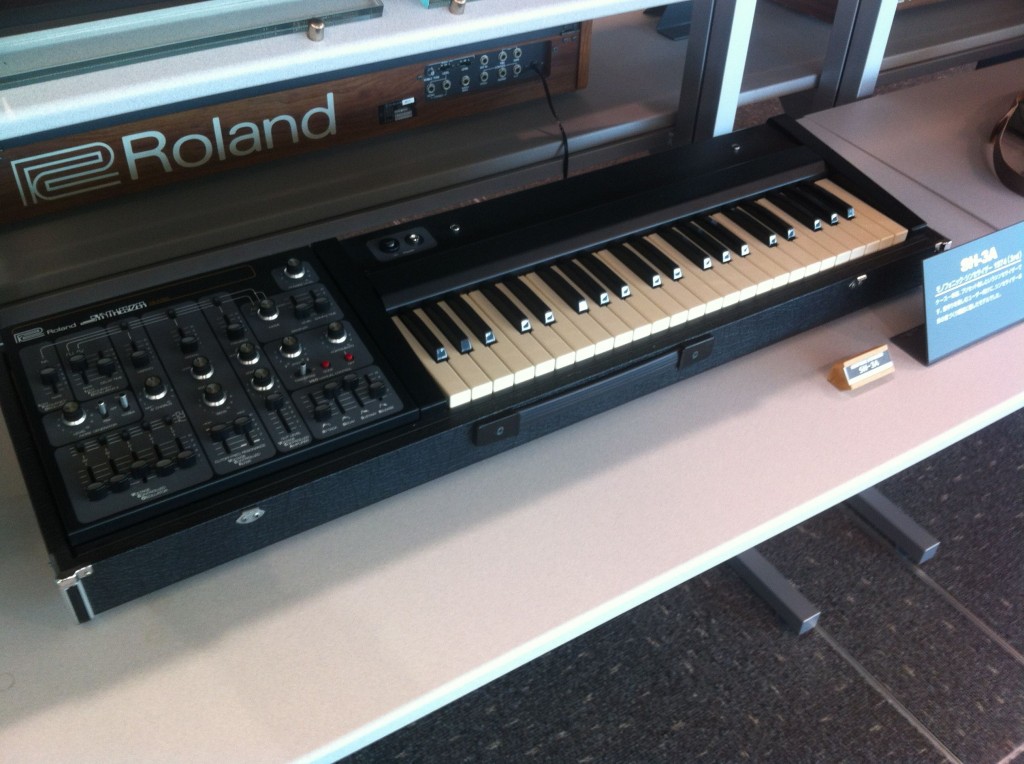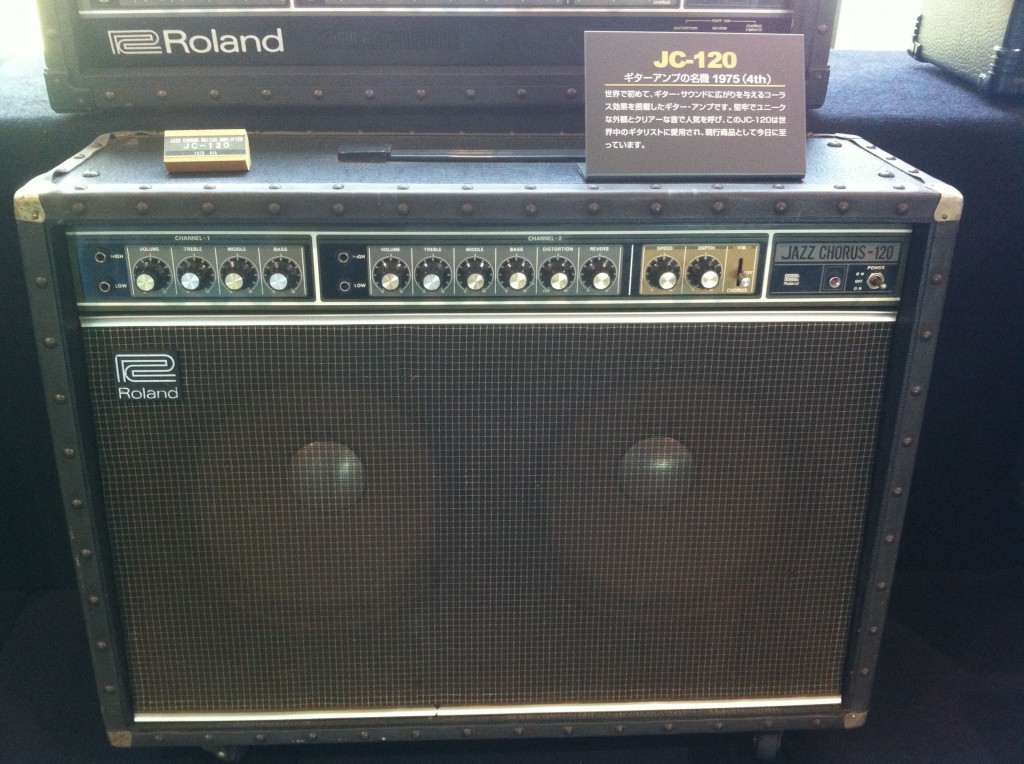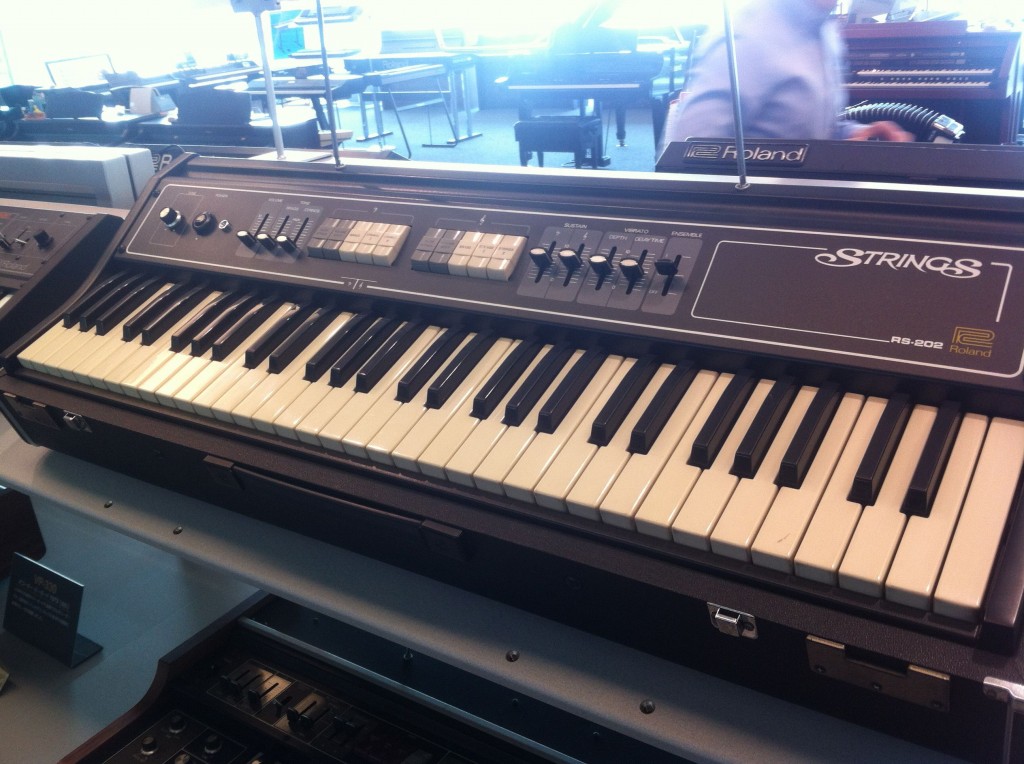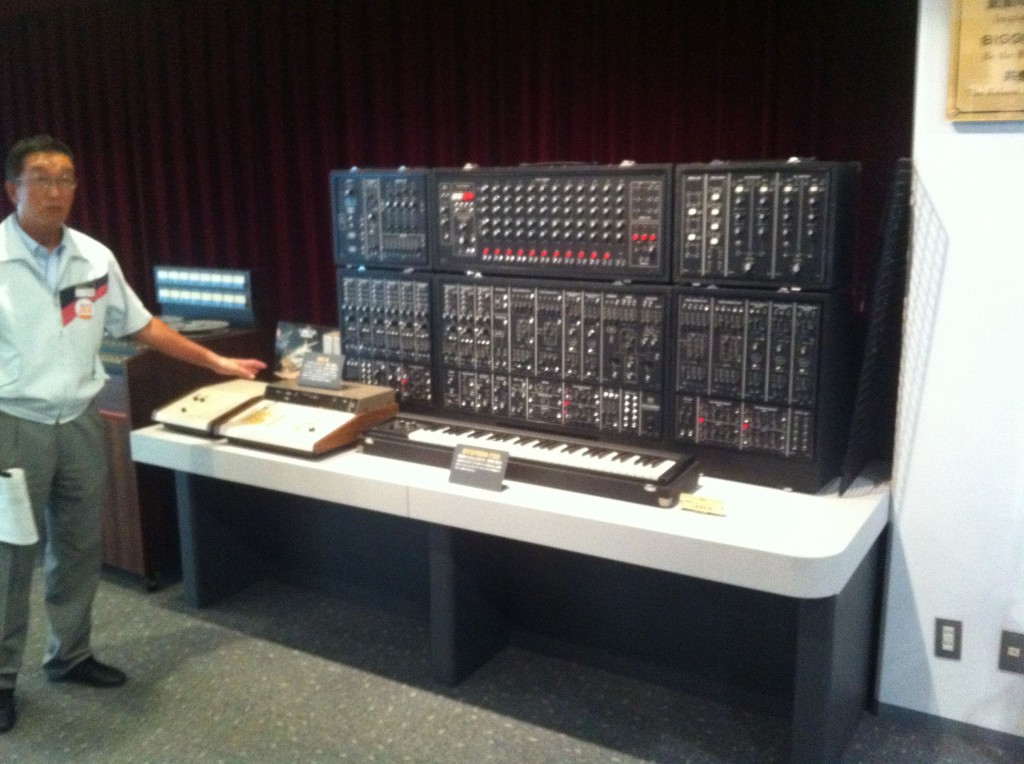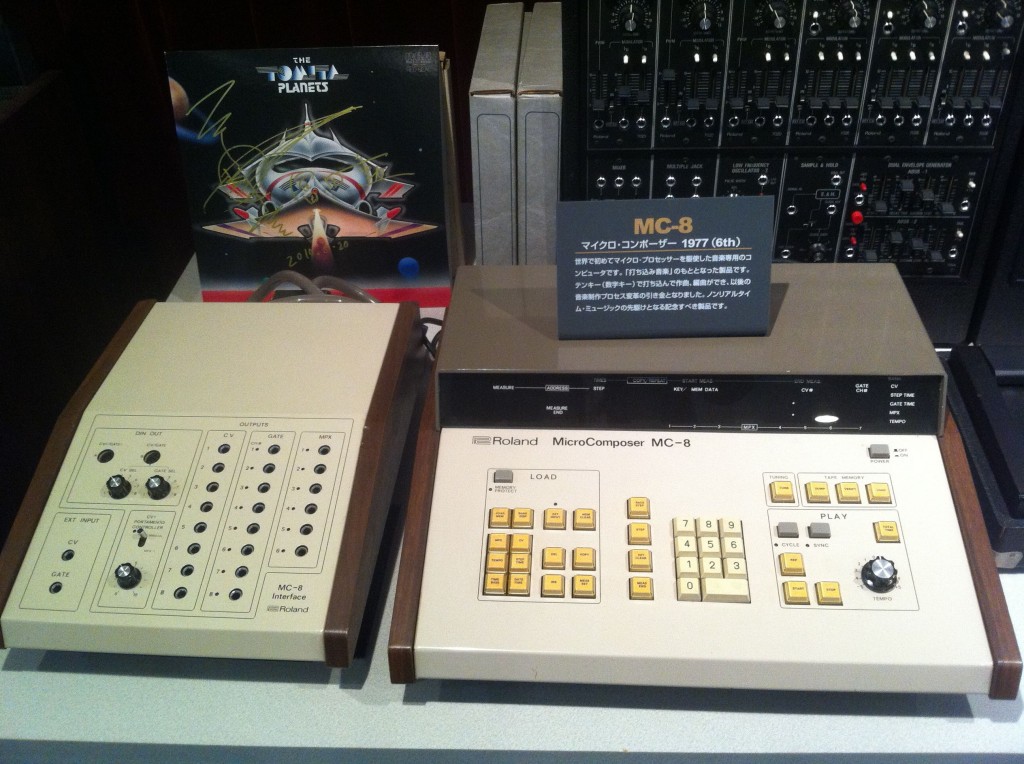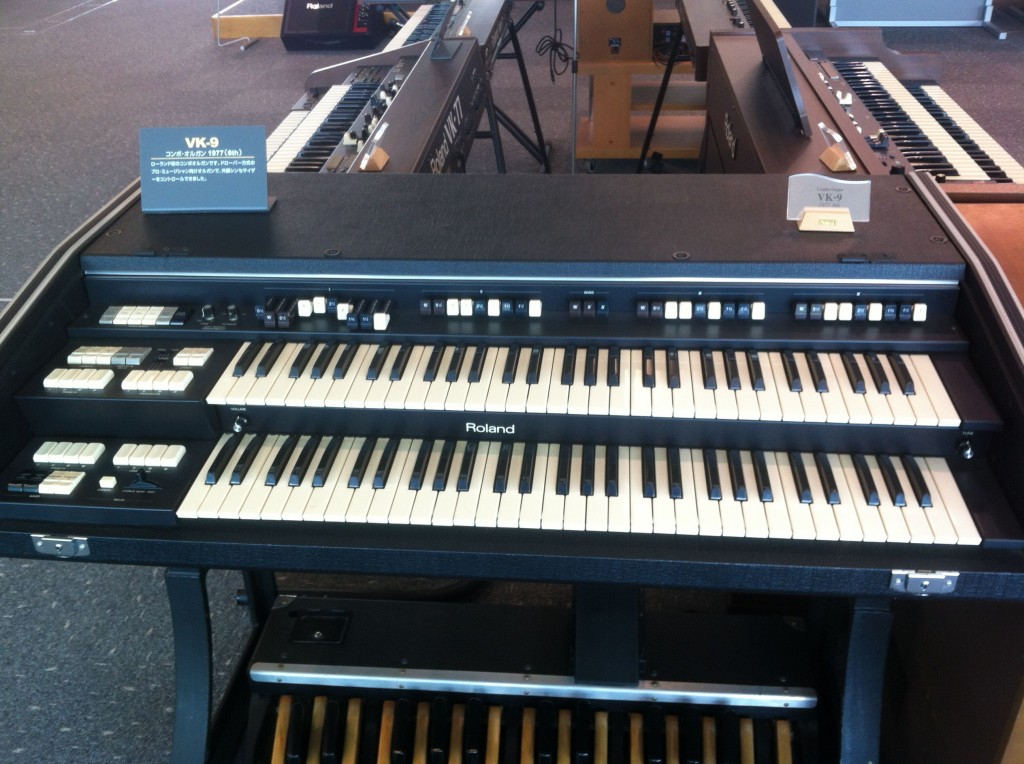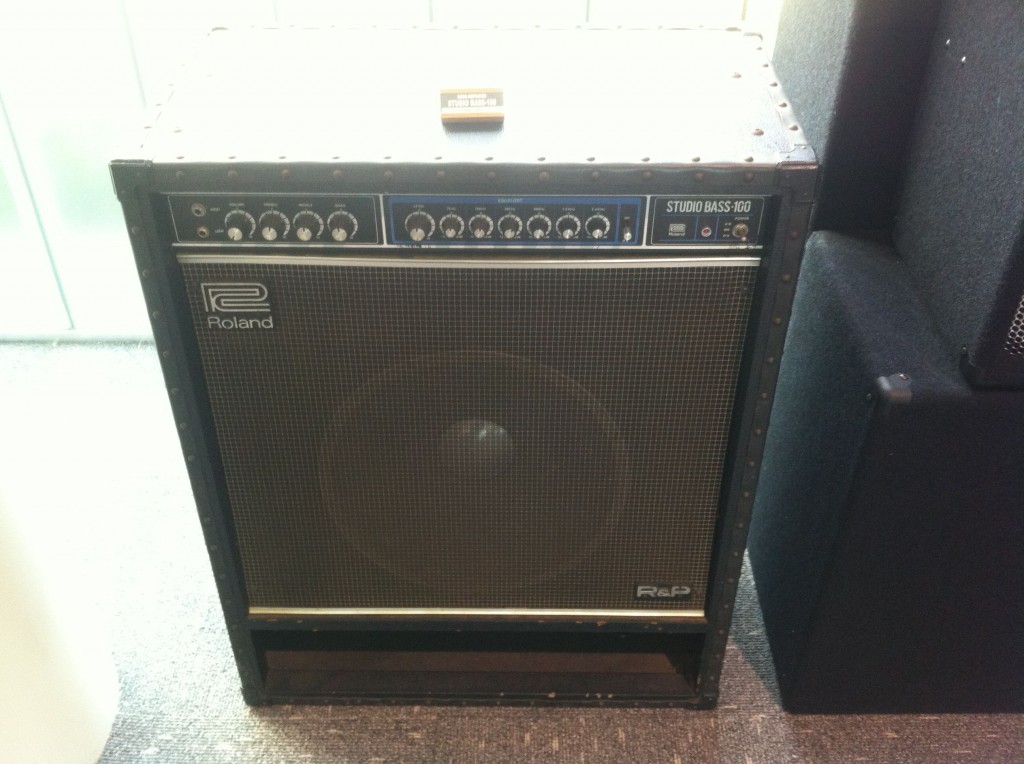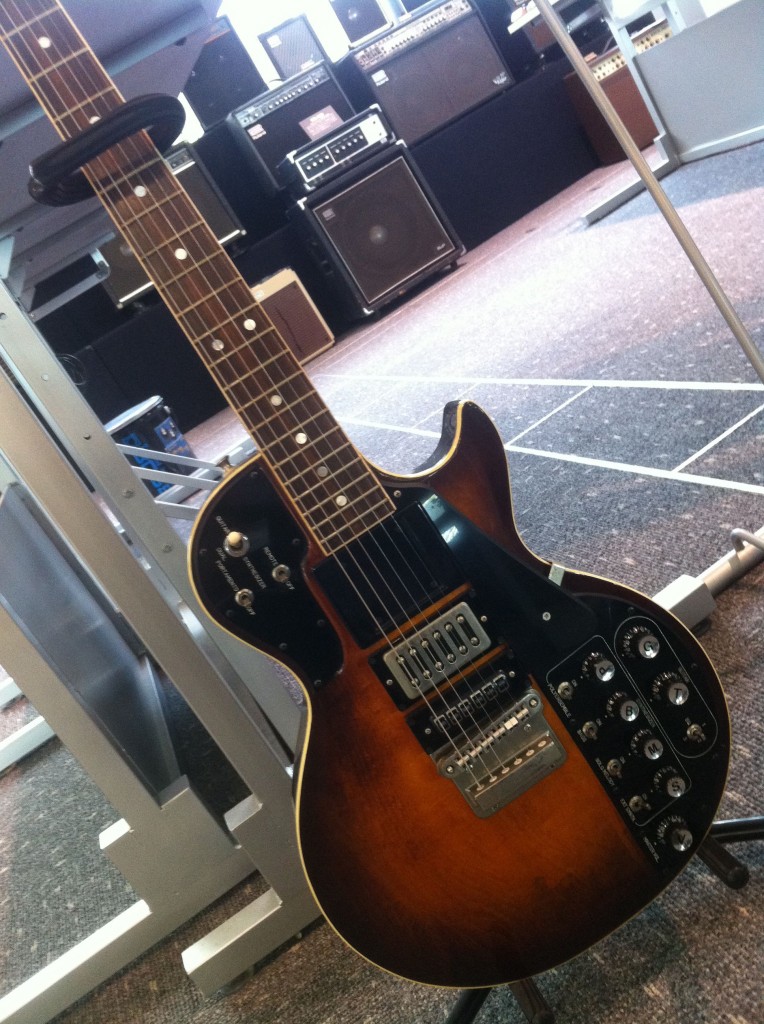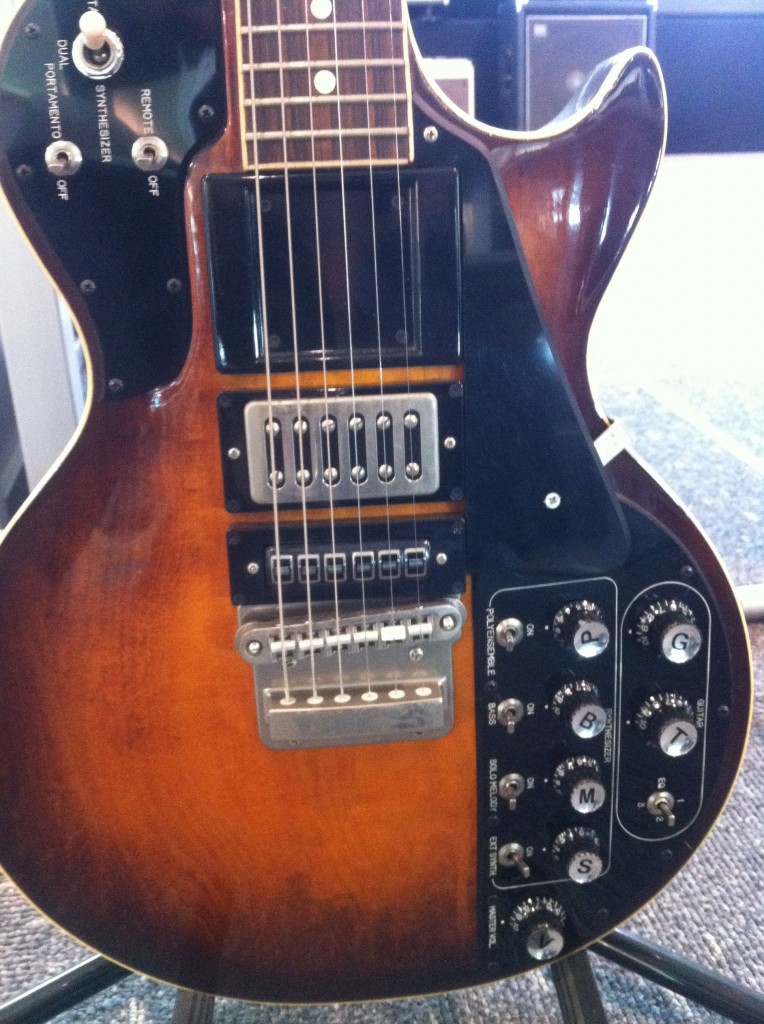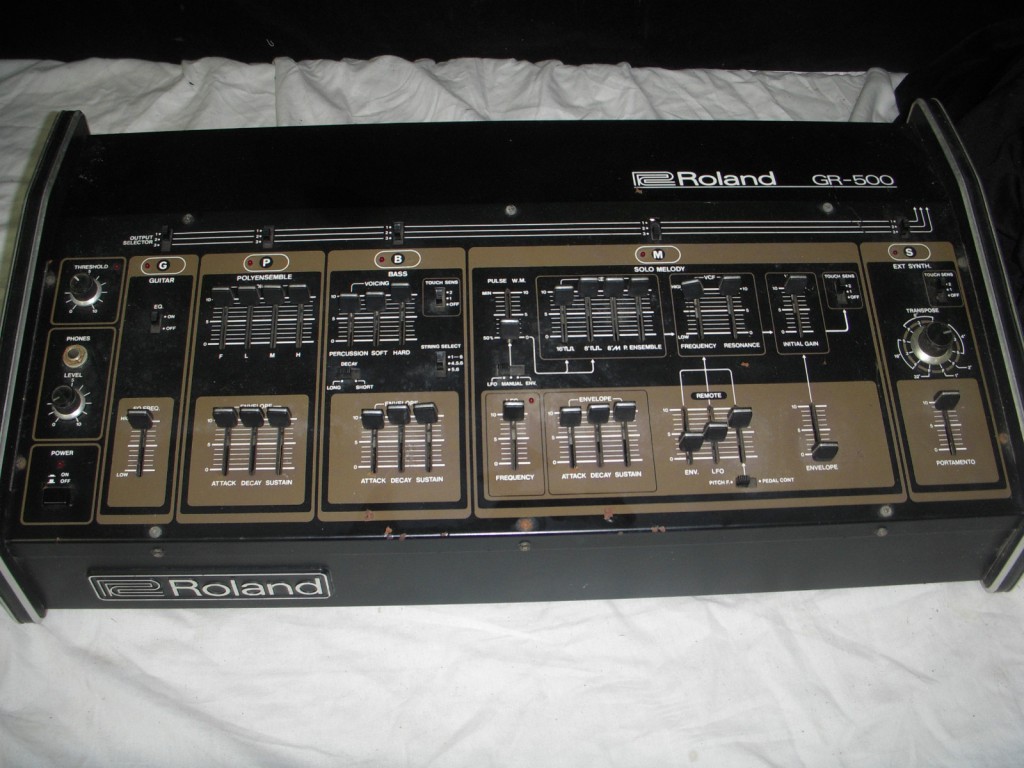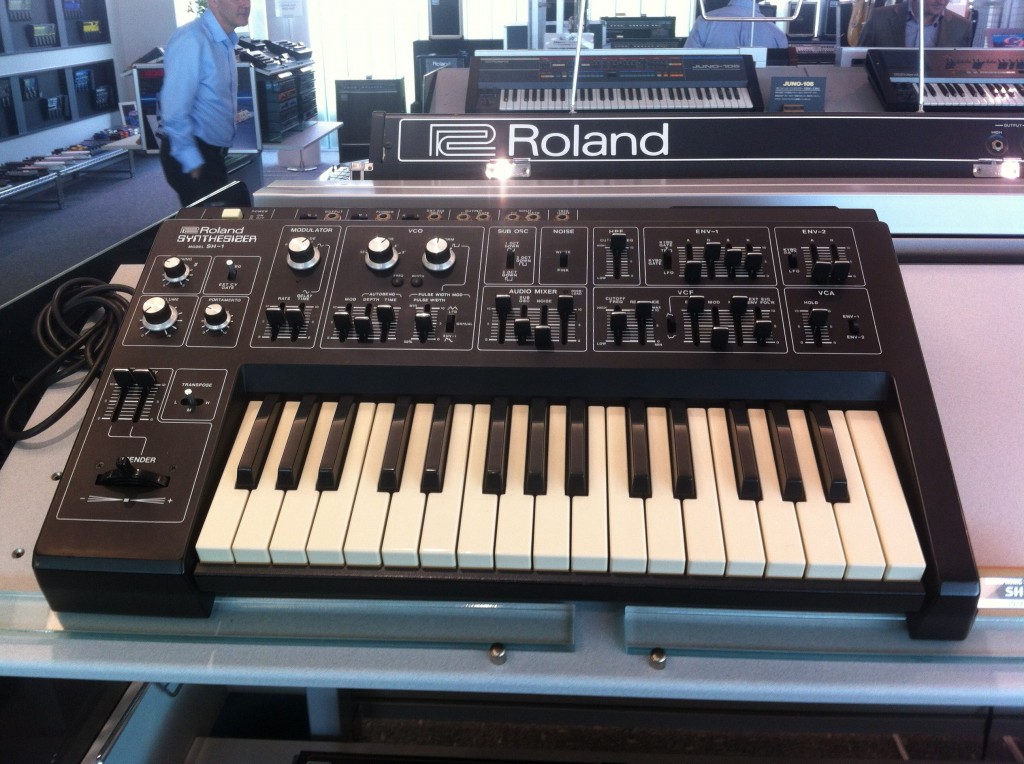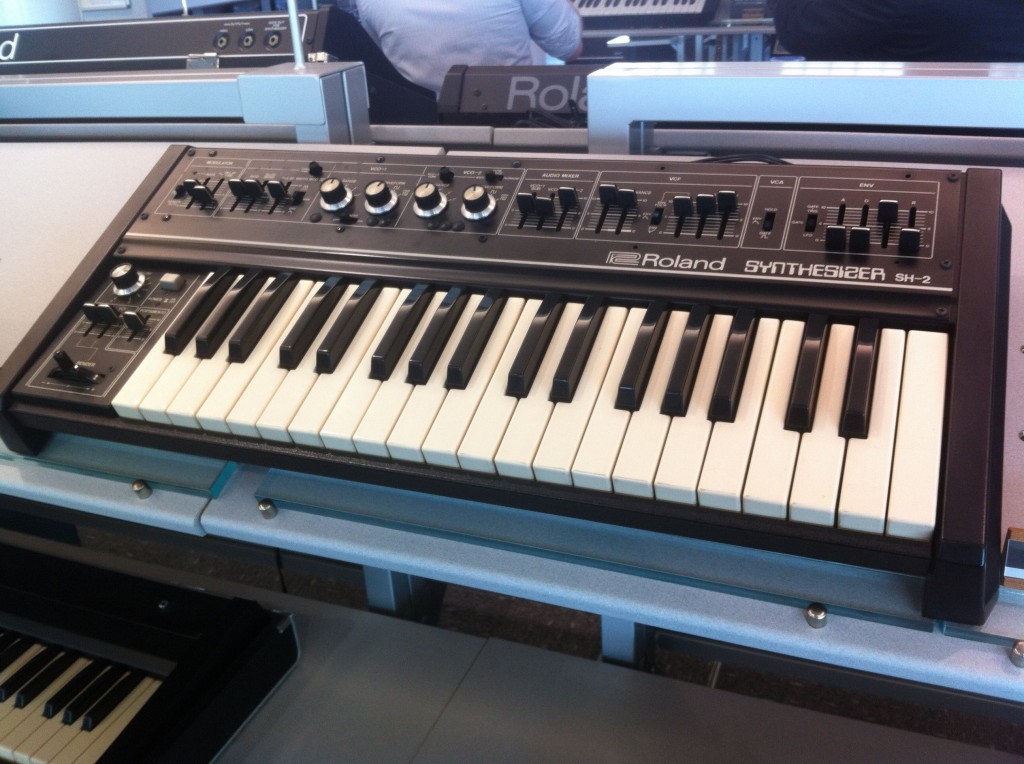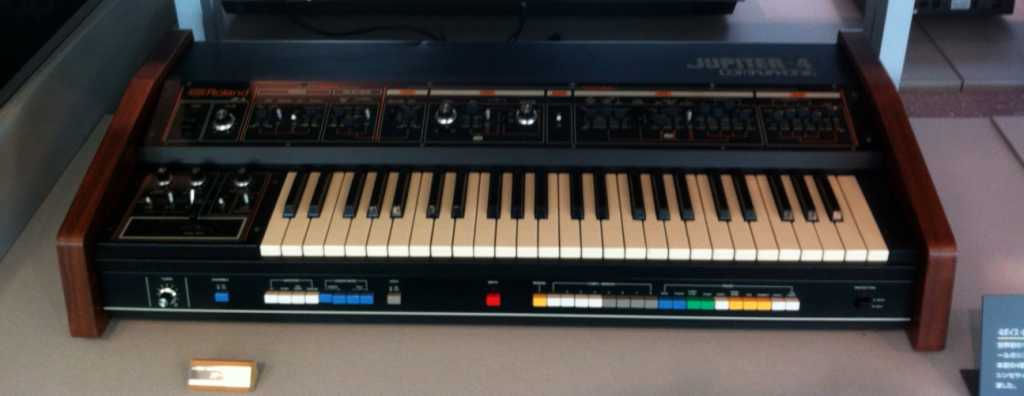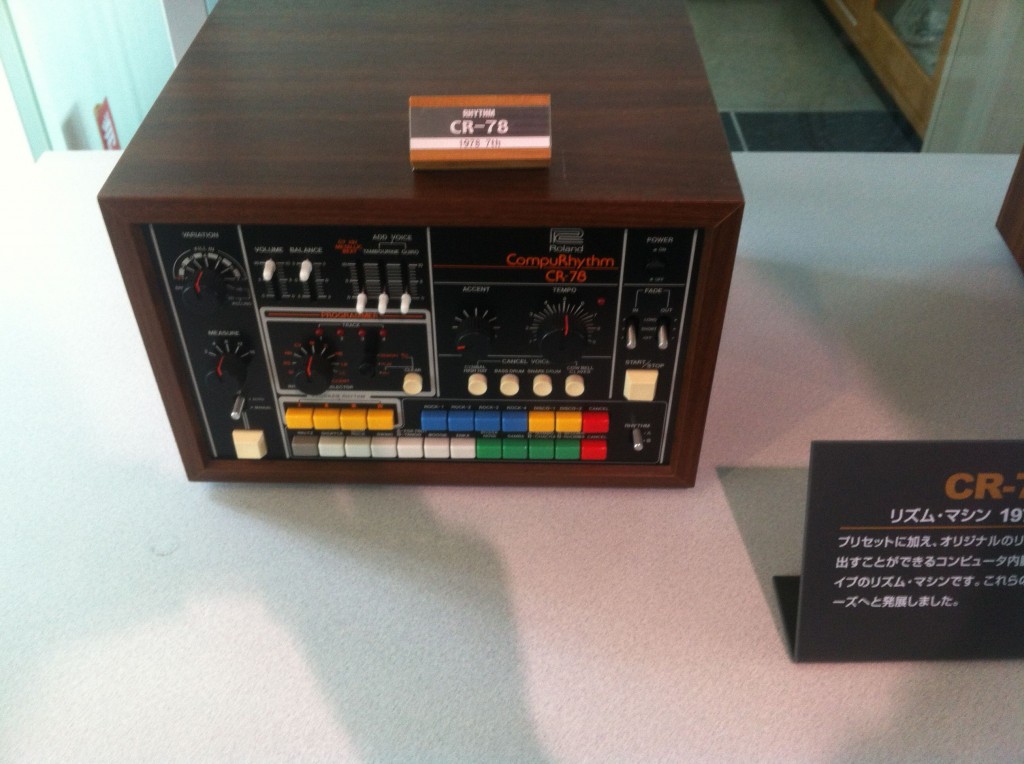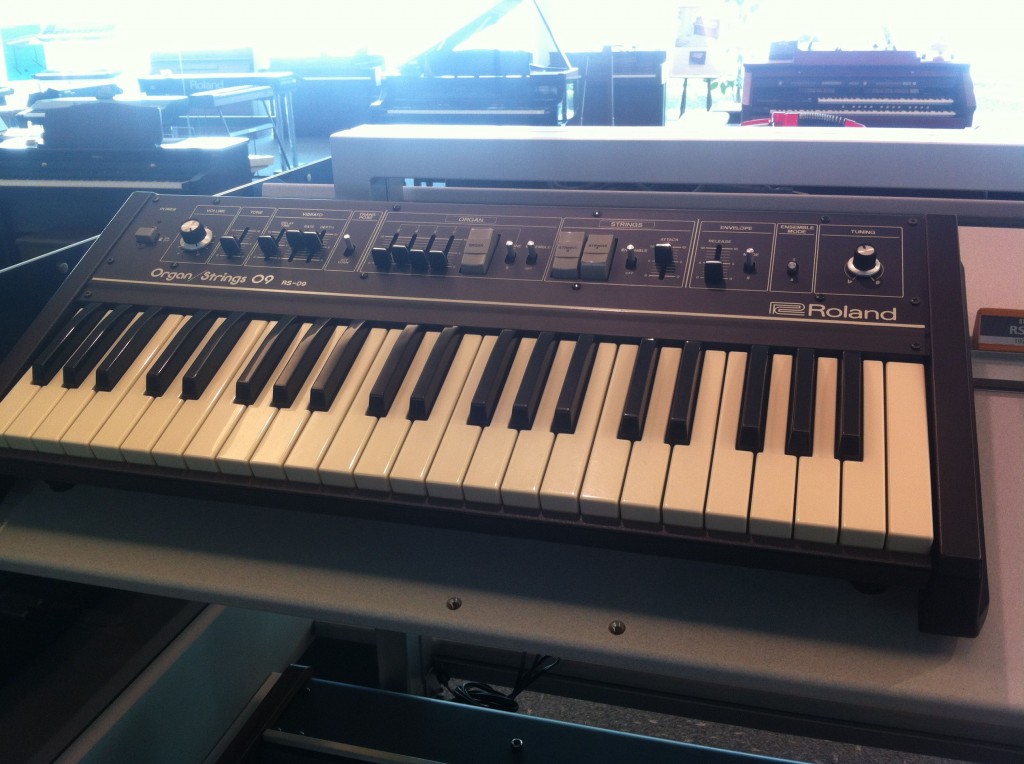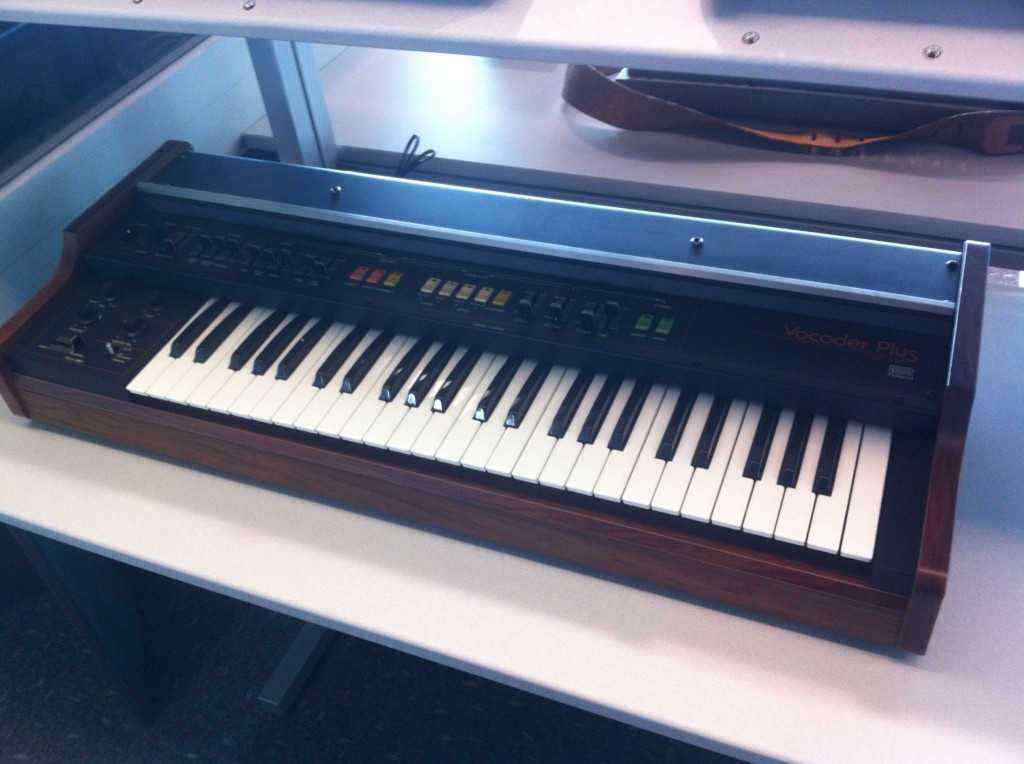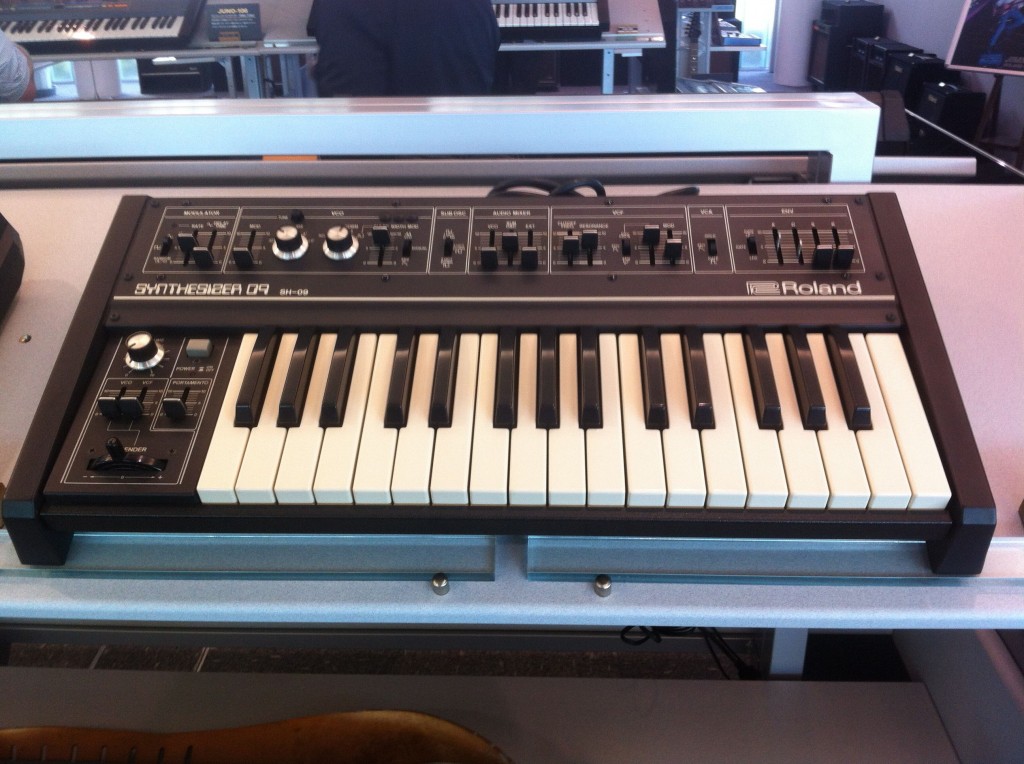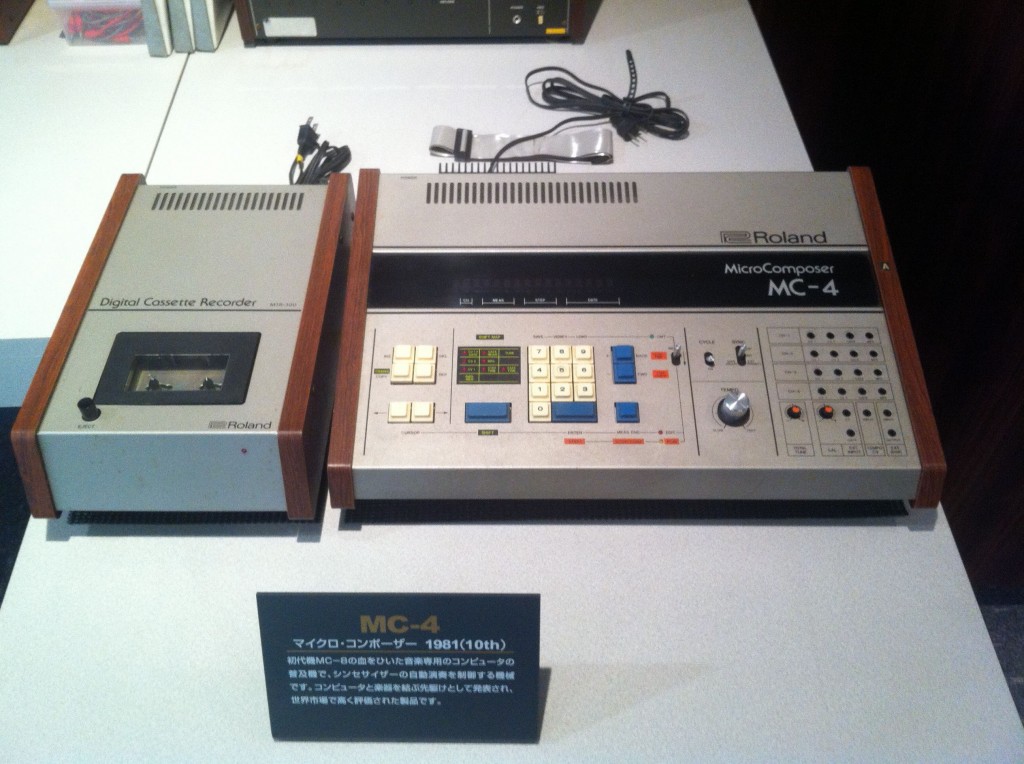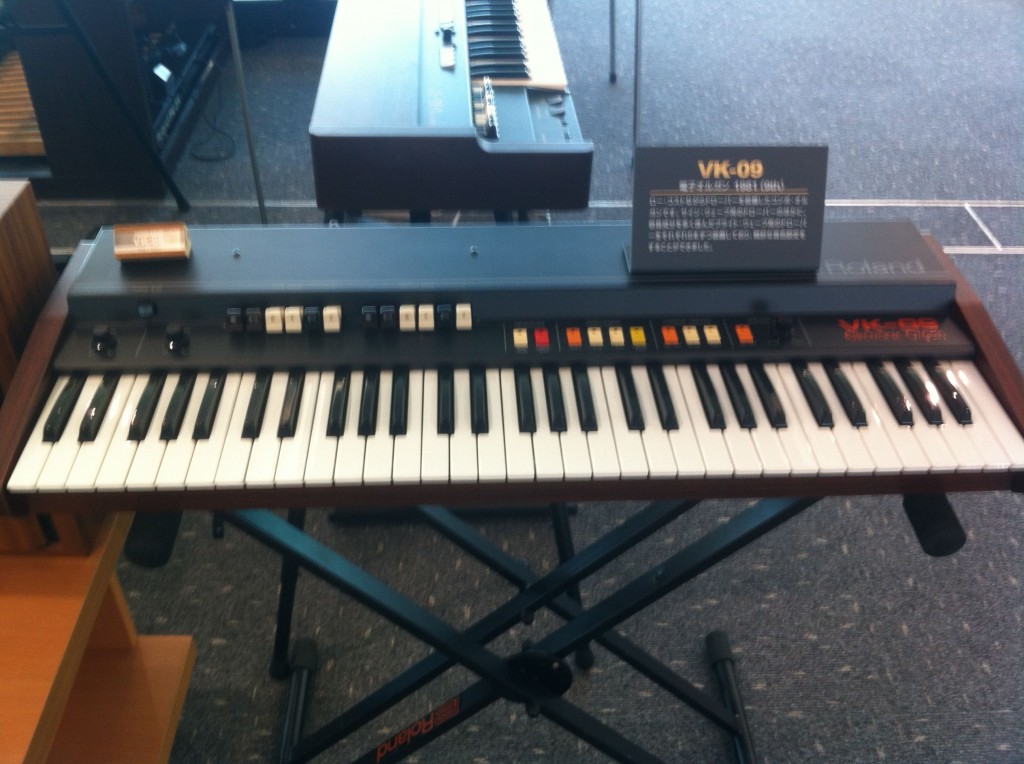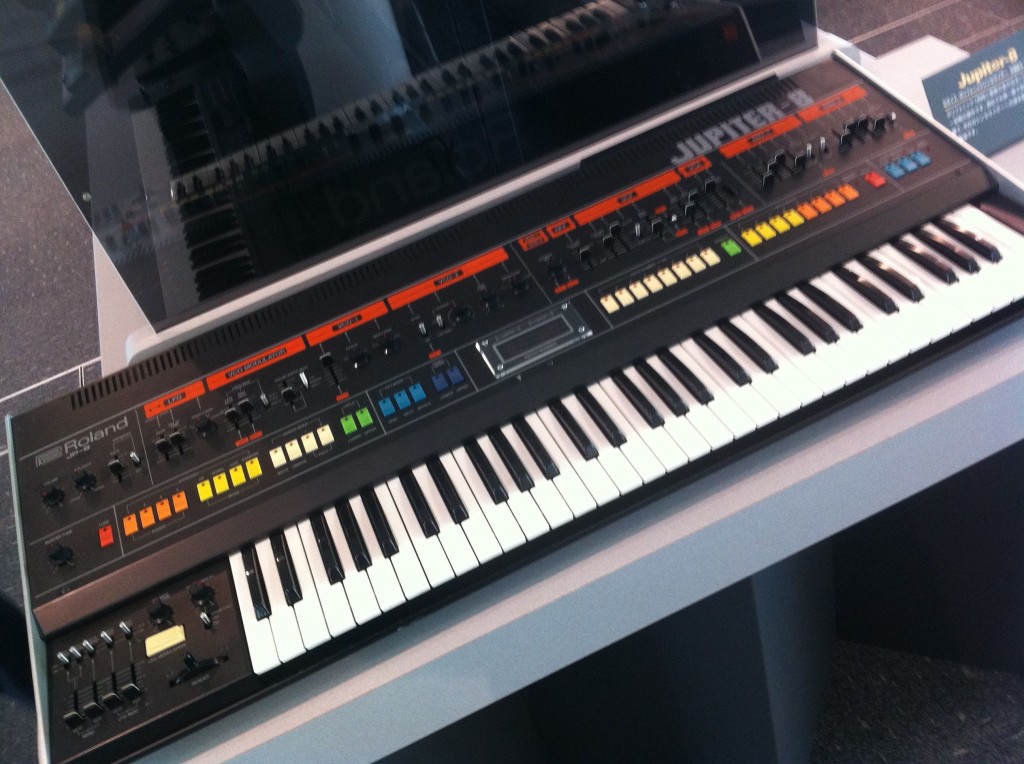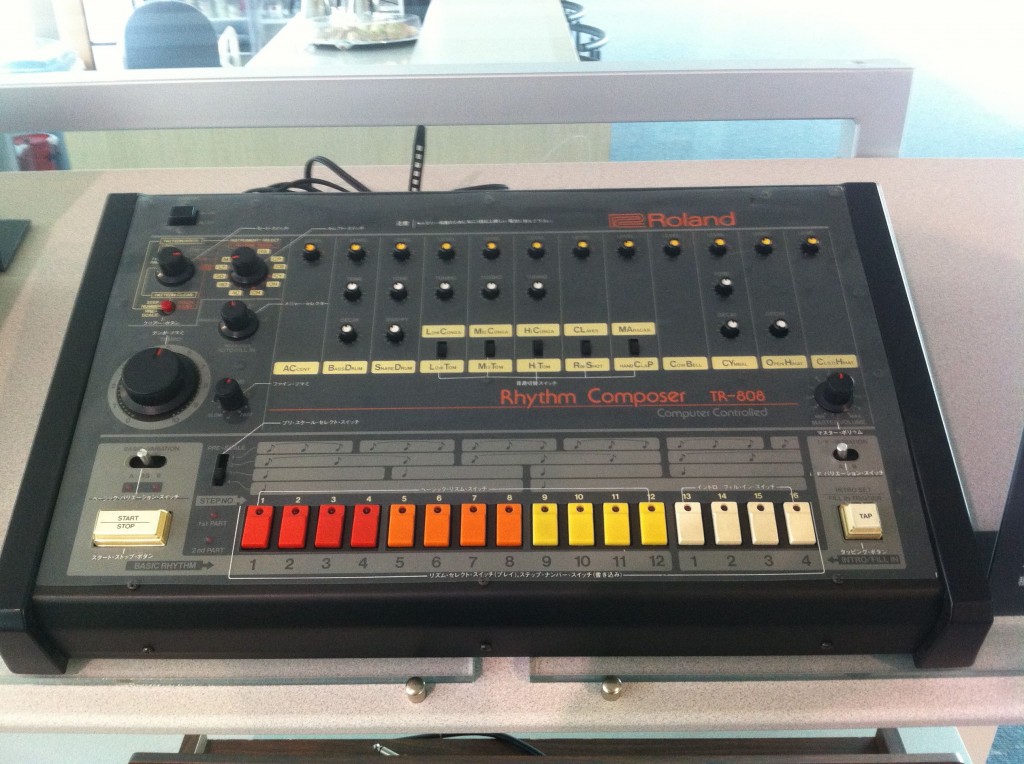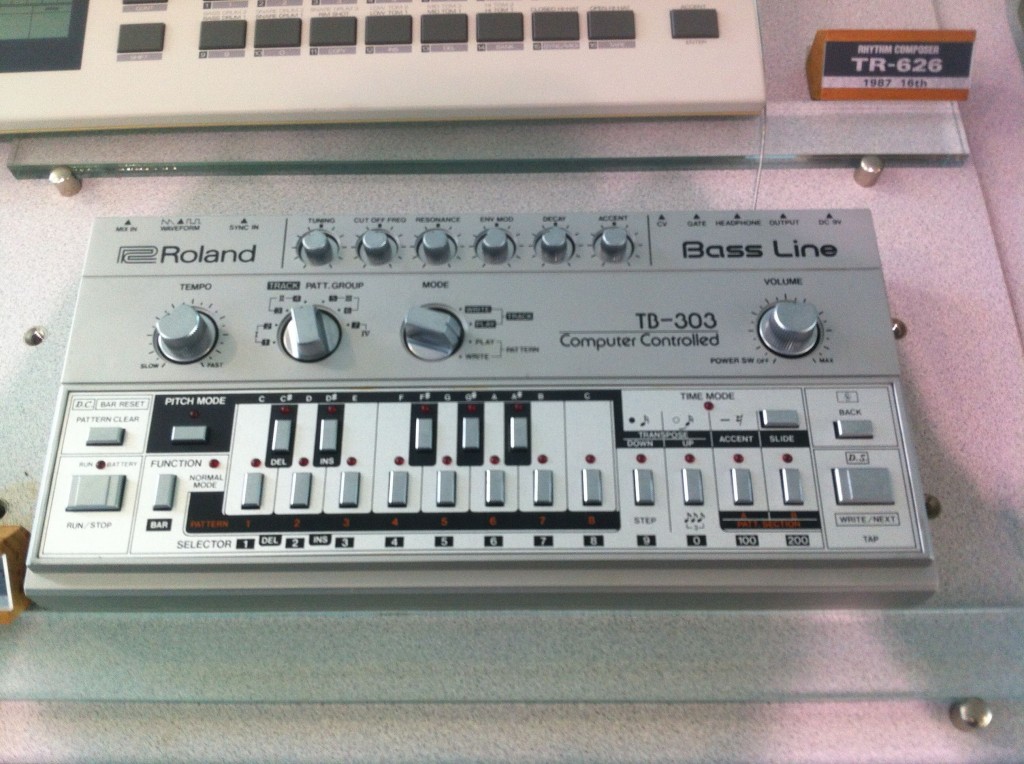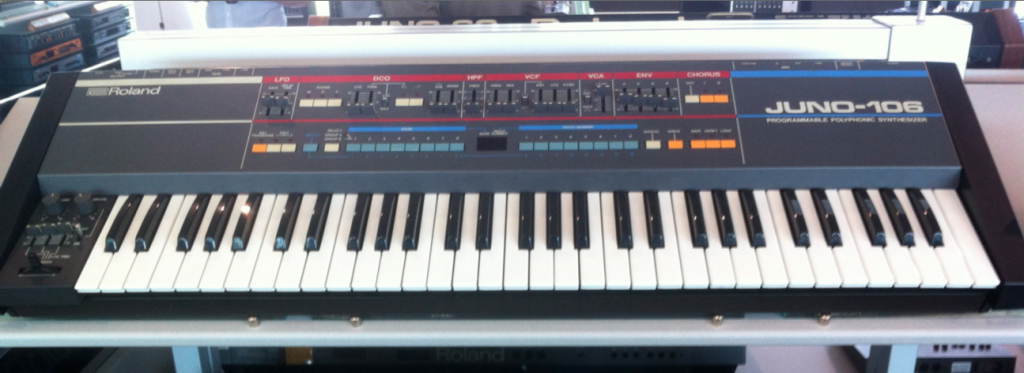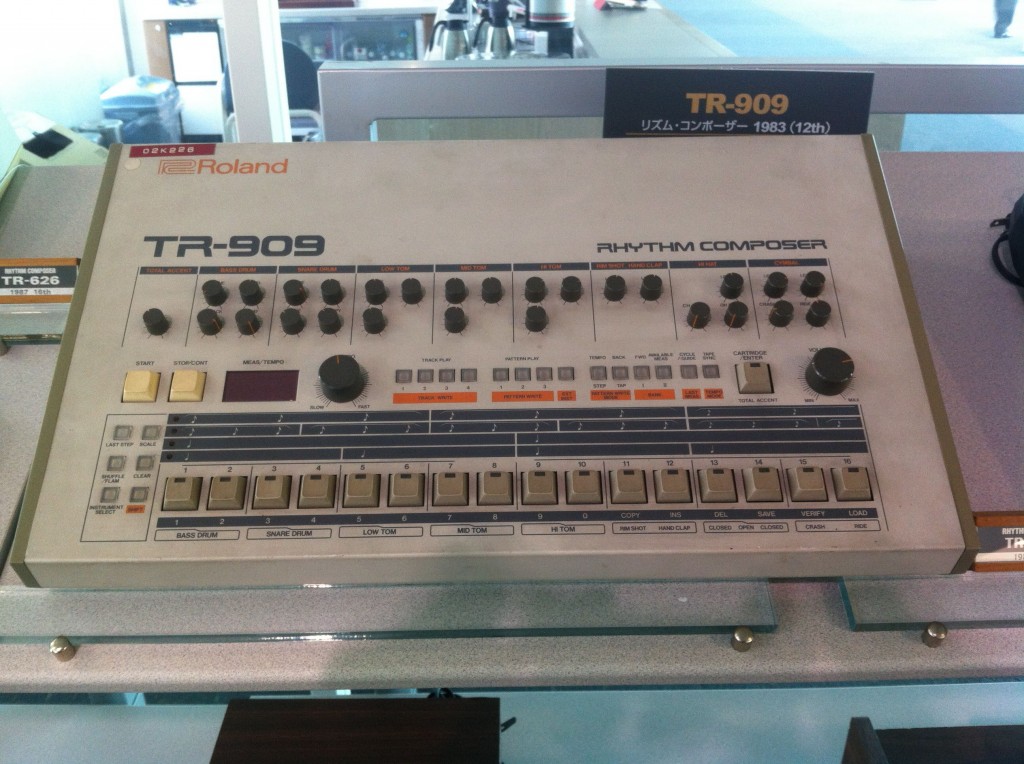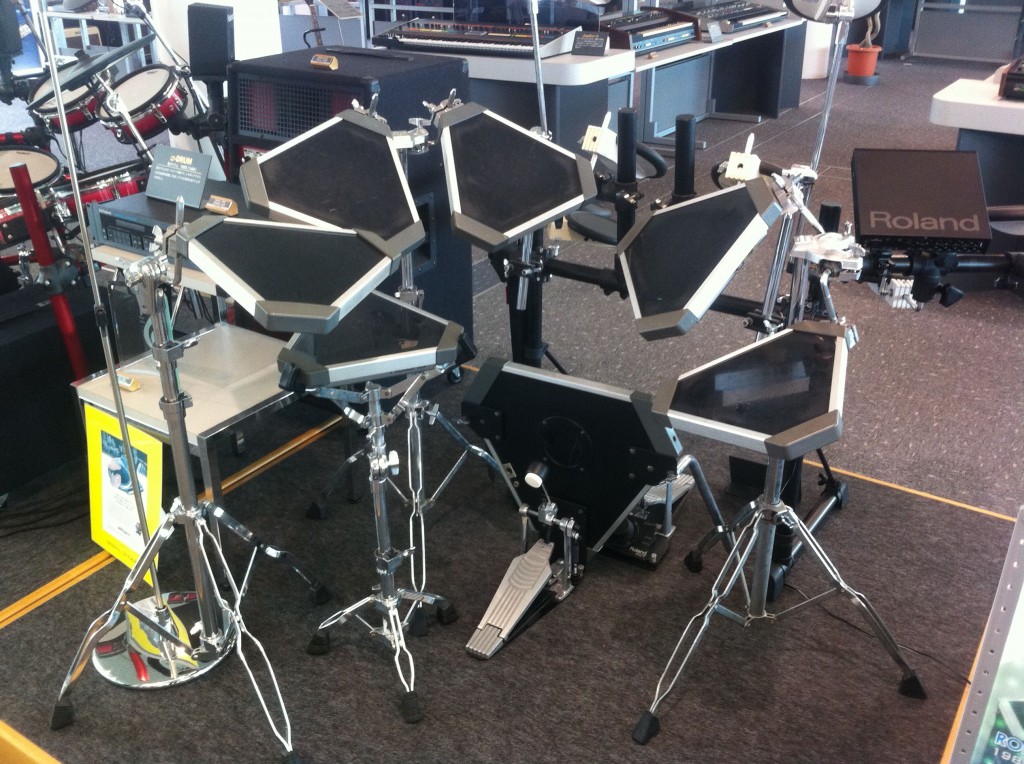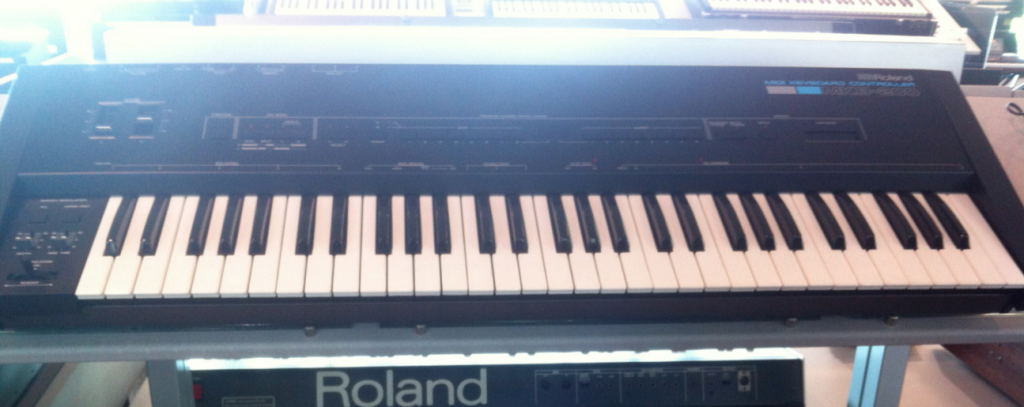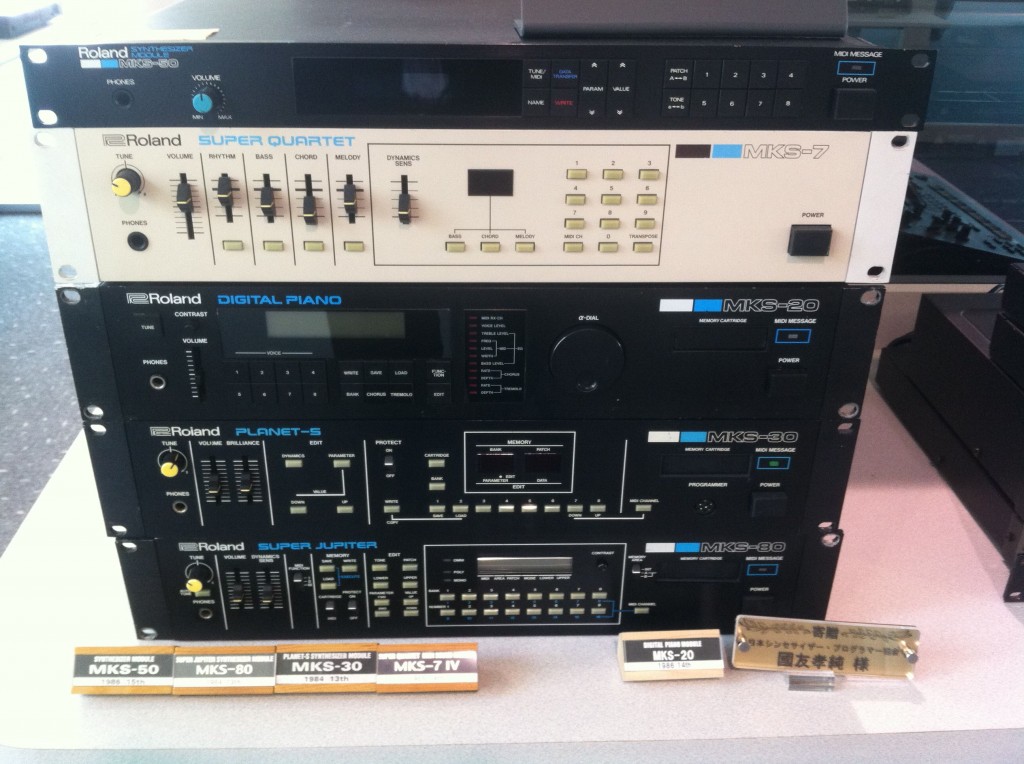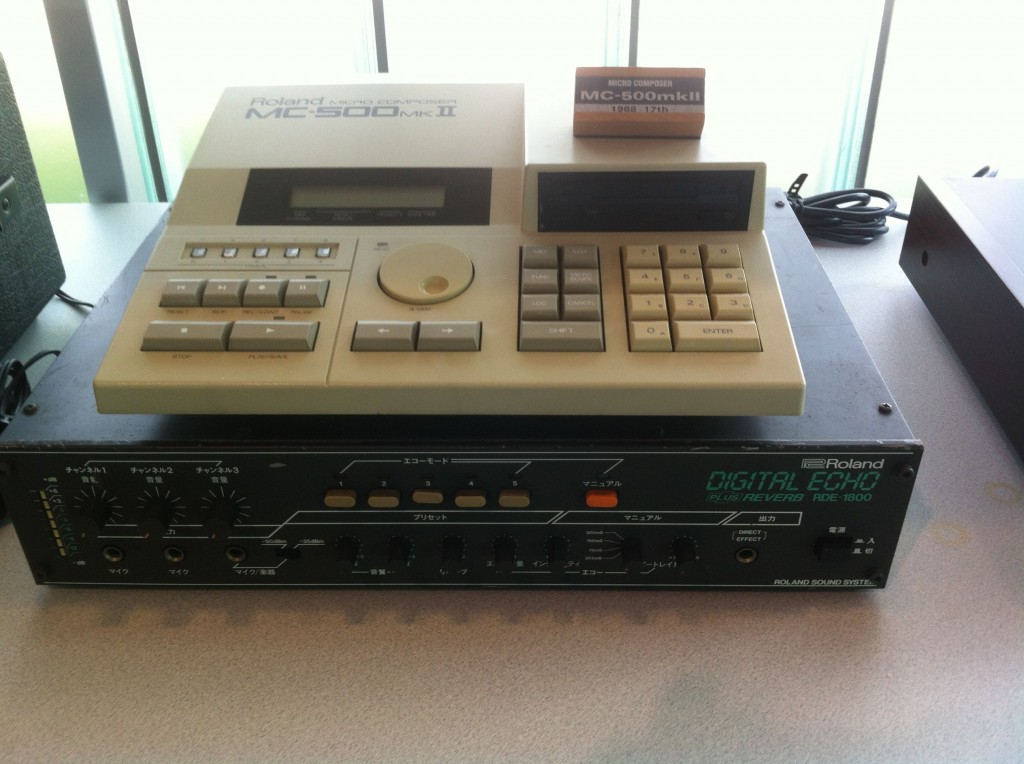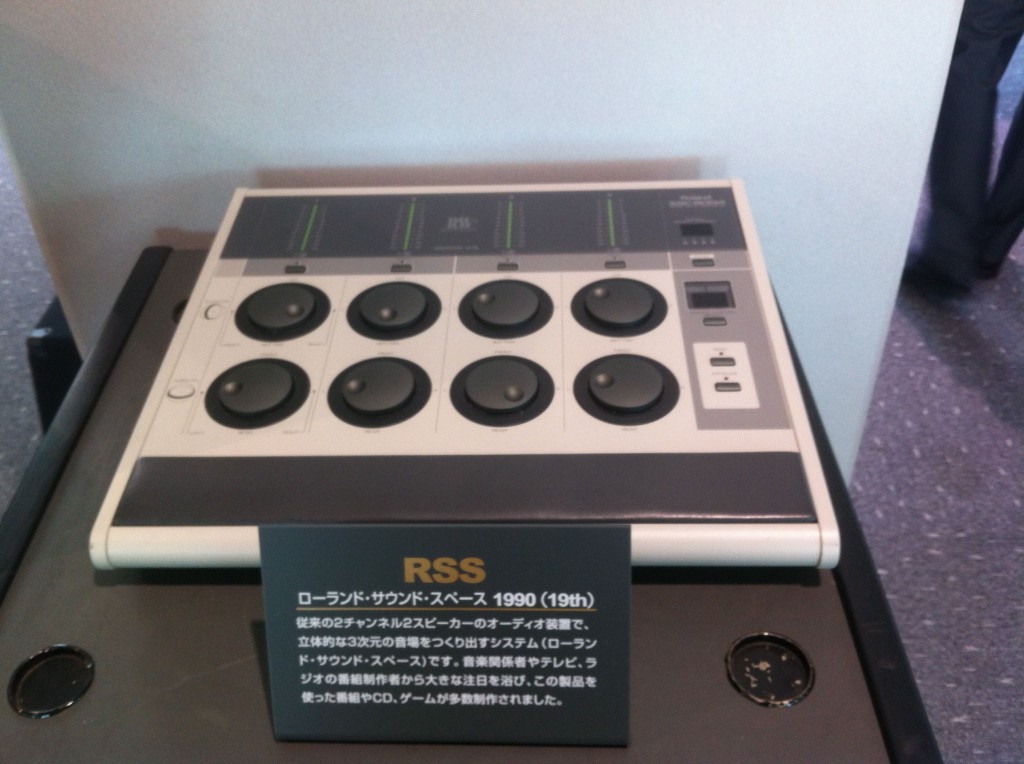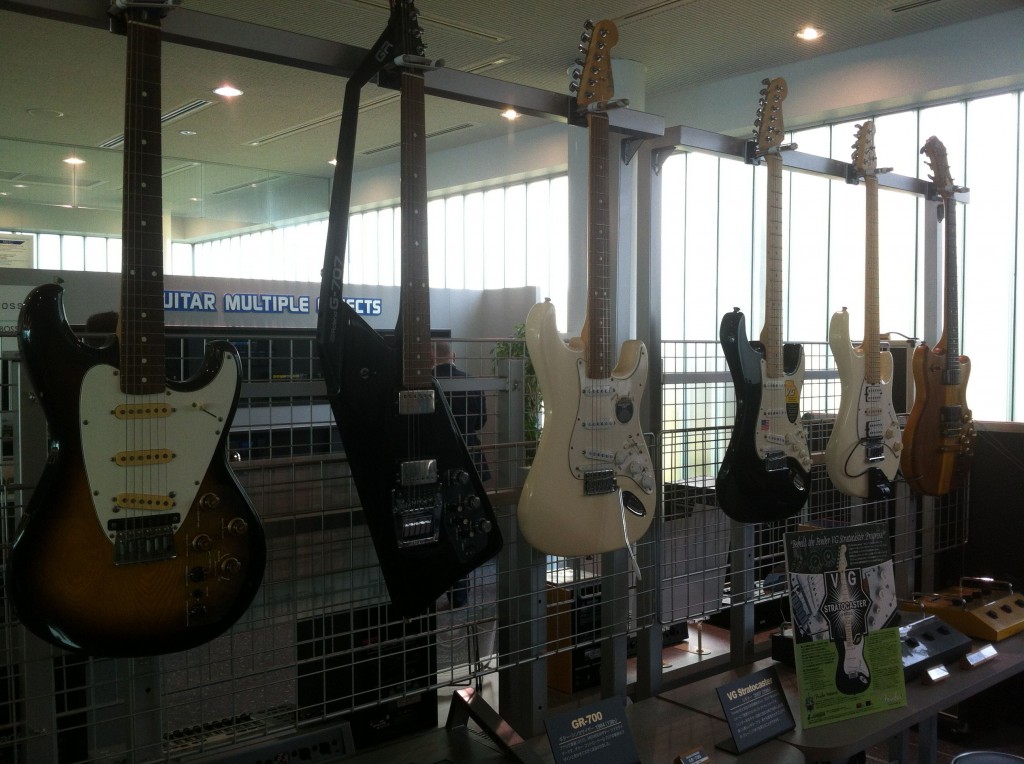ROLAND MUSEUM & COMPANY HISTORY
Posted on Fri 02 November 2012 in entries
Recently our Sales Director, Andy Legg, was lucky enough to visit the amazing Roland Museum in Japan, where he came into contact with a LOAD of classic Roland gear! Knowing that we would all be very jealous, he instinctively whipped out his camera phone and began taking snaps! We thought that you might also be interested to see some of the vintage treasures that he came across, so sit back, relax and enjoy...
However, let's start by introducing the history of the now famous Roland brand before we begin stepping through time and looking at gear!
Ikutaro Kakehashi was born in 1930 and was just two years old when both his parents died from tuberculosis. He spent most of his childhood living in Osaka, Japan and when he got older, he studied mechanical engineering whilst working in the Hitachi shipyards, where Japan's Midget suicide submarines were built.
Following World War II, Kakehashi failed to get into university on health grounds and so he moved to the Japanese island of Kyushu, where he became a geographical survey assistant. At the time he was just 16 years old, but as a natural entrepreneur, he noticed that there was great demand for repairing existing timepieces as there was no watch or clock industry in Japan following the war.
Interestingly enough, many now-famous musical companies were once related to clocks in some way! Torakusu Yamaha was also working as a watch repairer around the same time (no prizes for guessing what he went on to do) and the Hammond Organ Company was originally a small part of the Hammond Clock Company! Also, what do you think of when someone says Casio? Clocks and keyboards? Crazy!
Anyway, Kakehashi soon managed to get a part-time job with a watch repair business, but was soon asked to leave when he demanded to be taught the trade within the space of a few months rather than going through the usual seven-year apprenticeship! Despite the set-back Kakehashi was not put off so he went out and bought a book on watch repair and taught himself the skills that he needed before setting up his own business, the Kakehashi Watch Shop.
His business soon became very successful but Kakehashi was always keen to push himself and further his knowledge, so having taught himself the basics of how a radio works, he branched out and began to repair broken radios as well as watches and clocks, all-the-while working as an agricultural worker for extra income!!!
After four years of living in this way, Kakehashi liquidated the business to fund his entry into university back in Osaka. Having already achieved all of this, it's easy to forget that he was still only 20 years old!
Unfortunately, before his plans took full shape, Kakehashi contracted tuberculosis in both lungs and so was quickly admitted to hospital, where his ill health stranded him for a number of years. As treatment cost money, he soon found that the wealth that he had built-up was depleted and he no longer had the funds to enter university.
Again, this latest set-back would have put a temporary stop to most people's ambitions, but not Kakehashi's! Whilst in hospital he started up a mini-business by repairing watches and radios for staff and other patients.
Such was his health that Kakehashi had now been in hospital for 3 years and despite keeping himself busy with small personal inventions, his condition was becoming worse. Due to these circumstances, Kakehashi was selected as a guinea-pig to test a new drug, Streptomycin. This proved a stroke of luck, as within a year, his health had improved so much that he was able to leave the hospital! Had he not been selected and with deteriorating health, it is highly likely that the 'Roland' company would never have existed as the drug was very expensive and out of reach for most people, including Kakehashi.
In 1954 and struggling to find a job, Kakehashi opened his own electrical goods and repair shop, which quickly became very successful. However, in 1955 he decided that he also wanted to begin developing electronic musical instruments that could produce simple monophonic melodies.
Kakehashi originally attempted built his own Theremin, but soon found that it was extremely difficult to master (try playing the one on demo in our store and you're likely to agree with him)! Noting that the Theremin was probably not going to have huge commercial success, Kakehashi now became interested in creating an instrument with playable notes, so he set his inventive mind to it and created a four-octave organ using bits of telephones and transistor oscillators amongst other things! However, this original prototype did not sound quite as he had envisaged and so it was never mass produced.
Despite dabbling in other areas such as guitar amplification, Kakehashi ploughed on with his interest in organs and in 1960 (a year that he rebranded his company as Ace Electronic Industries or 'Ace Tone'), he designed an organ that became the Technics SX-601, having been recommended to the owner of Technics via a friend of a friend. Ace Electronic Industries was now up and running and in 1963, they added guitar amps to their product range, but Kakehashi was quickly becoming interested in electro-mechanical percussion instruments.
In 1964, Kakehashi built the Ace Electronics R1 Rhythm Ace and decided to take it along to the NAMM show in Chicago, along with a monophonic instrument called the Canary. Unfortunately for Kakehashi, despite receiving interest, he did not receive any distribution deals.
He had been knocked back again, but once again, he just got right back up, improving the R1 by adding pre-programmed patterns with the addition of a diode matrix that determined the position of each instrument in the pattern. This upgrade was released with the FR-1 Rhythm Ace, which was introduced in 1967 and the technology was snapped up by the Hammond Organ Company and featured on their latest organs.
Over the next few years, Ace grew and grew, working closely with Hammond and the company, under Kakehashi's guidance, designed a number of new guitar amps, effects units, rhythm machines and combo organs, which included their TOP range and the dual-manual GT-7.
In 1971 Kakehashi helped develop the Piper Organ, which was the world's first single-manual organ to incorporate a rhythm accompaniment unit and it went on to become one of Hammond's most popular products EVER!
As Ace grew, so it became more and more attractive to investors and as such, Kakehashi eventually became a minority shareholder in his own company! However, for many years this was not a problem as the majority shareholder, Kazuo Sakata of Sakata Shokaim, also shared an interest in organs and the two got on well. However, things did not stay so rosey forever...
When an industrial company, Sumitomo Chemical, bought Sakata Shokai, they also acquired Ace, but having no understanding or interest in Kakehashi's work, he soon decided to resign from his own company having found working together intolerable. And so it was, in 1972 he walked out on the business that he built up and that was now turning over nearly \$40 million per year. Another set-back... or was it?
One month after leaving Ace, on 18th April 1972, Kakehashi set up another business and one that you may have heard of - it was called 'Roland Corporation'. Knowing his quality, having worked alongside him for years, the Hammond Organ Company immediately put in an offer for a 60% shareholding stake, but Kakehashi had learned his lesson and had no plans to be a minority shareholder in his own business again, so he decided to go on on his own, using his own money to fund the business.
Kakehashi rented a shed and employed seven staff that had also left Ace Electronics. Using his reputation, Kakehashi manage to convince parts suppliers to offer 90-day payment terms and then aimed to design, build and export a rhythm unit before the bills were due and the 'money-people' came knocking on his door! So there you have it - Roland actually began life in a shed!!!
The decision to export was a clever move by Kakehashi. Yamaha and Kawai had built up huge reputations and were now dominating the Japanese music market. With such competition Roland would have found it nigh-on impossible to earn enough money to survive, despite Kakehashi's drive and ambition.
Kakehashi set out on his travels, firstly to Canada, then to New York and also to Denmark (where he spoke to a company with subsidiaries in the UK, Switzerland and Germany). His intention was to get orders for a rhythm machine based on his reputation and ideas because as of yet, no Roland product existed! In the end he managed to obtain a small number of orders from each company and so he now had the money to fund the design and build processes.
Roland's first ever product was the TR-77, a rhythm-box that allowed you to merge patterns, had independent volume controls for each instrument, plus two- and four-beat patterns and a fade-out feature. Also in this range (and released a little later) were the TR-55, which had a tabletop design, and the TR-33, which had a cut-out body shape for mounting underneath a piano or organ.
Along with the TR- rhythm boxes, Roland also developed a number of effect units, the first being the AF-100 Bee Baa (a fuzz box with four knobs on the rear panel) and the AS-1 Sustainer.
Over the next few years, Roland grew and grew, expanding their range as they went. They produced Japan's first synthesiser, the SH-1000 and are now known as one of the world's leading music companies, having designed and manufactured a number of instruments that have rightly earned the status of 'legendary' - think of the amazing Jupiter-8 analogue synthesiser, which is still considered by many to be one of the best synths ever made and has been immortalised by Arturia as a software instrument, the TB-303, which helped kick start Rave music with that famous Acid sound, the TR-808 and TR-909 drum machines, samples of which you will still hear in many chart tracks today, and their amazing modern TD electronic drum kits, plus loads more.
Now, let's take a journey through time and drool over a selection of their classic instruments...
Let's start with the Roland Slogans, which are displayed on a plaque in the museum. Just in case you can't make them out because of the reflecting light (and you can't read Japanese!), the plaque reads:
"Inspire the Enjoyment of Creativity."
"Be the BEST rather than the BIGGEST."
"The Roland Family - Cooperative Enthusiasm."
So, here it is, the Technics SX-601; an organ designed in 1960 by Roland founder Ikutaro Kakehashi, as mentioned in our Roland History introduction.
The Canary S-3 was designed and built in 1962 and was a three-legged clavioline-type organ instrument.
The Rhythm Ace FR-1 (originally made in 1964 but not released until a few years later) was the update of the R1 Rhythm Ace, which unsuccessfully returned from the NAMM show a few months earlier. However, the inclusion of built-in rhythms on the FR-1 made it a much more desirable product when it was released in 1967 and the technology was adopted by Hammond for their state-of-the-art organs at the time.
Built in 1967, Ace Tone produced the Rhythm Ace FR-3, a portable analogue drum machine that could play analogue pre-programmed rhythms! This is essentially an ancestor of the TR-808, which went on to revolutionise popular music as we know it today!
An immaculate condition Ace Tone TOP-1 combo organ, which was released in 1968. Roland were rocking the 'red' long before Nord were even established!
We've been finding it extremely difficult to get any information on its release date, but anyway, here is the Ace Tone VM-80, a 6 channel mixer with authentic spring reverb and 2-band EQ on each channel!
The Ace Tone Rhythm Ace FR-6 (released around 1972) is a rhythm box with a number of built-in styles, which showed huge improvements from the original R1, which failed to drum up sufficient interest and secure backing at the 1964 NAMM show.
Ok, so we didn't get a picture of it ourselves (this one was taken from (http://media.soundonsound.com/sos/nov04/images/roland04.l.jpg), but we couldn't not include the TR-77 in our round-up as it was the first ever Roland product (released in 1972)!
The TR-77 was a rhythm box that was housed in a wooden case and featured a music-rest as it was designed to sit on top of an organ. At the time, the TR-77 was a really hi-tech piece of kit and it even featured sliders for controlling the volumes of all the different sounds individually! There was also the crazy 'Up Tempo' switch, which doubles the speed of the current rhythm!
The Roland TR-77 featured four groups of rhythms: Latin, Jazz, 2-Beat and 4-Beat and it also allowed you to combine rhythms if you so wished.
From 1973 comes the Roland SH-1000 - the first keyboard instrument ever produced by Roland and Japan's first synthesiser! It was designed to be a complete home organ and featured coloured preset selector tabs below the keyboard, with all the parameter controls bunched on the left-hand side of the instrument.
The SH-1000 is a monophonic analogue synth with one oscillator, a lowpass filter, an ADSR envelope and two LFOs, plus
white noise, pink noise, portamento, octave transposition and a Random Note Generator. You couldn't save your own
presets with the SH-1000 but you could create your own sounds if you
desired{width=1024 height=764}](https://community.absolutemusic.co.uk/uploads/2012/11/IMG_0961.jpg)
Here is a selection of classic Roland products. On the bottom left is the Roland RE-201 Space Echo, which was produced between 1973 and 1988. This is placed on a shelf with a selection of other Space Echo effects.
Above the RE-201 is the Roland CSQ-100, a microcomputer-controlled digital CV/Gate sequencer from 1979 with the CSQ-600 (another digital sequencer) on its right.
This is the Roland SH-3A, which was in production between 1974 and 1976. The SH-3A is a programmable analogue additive synthesiser, which features a single oscillator for monophonic sound. The SH-3A could mix up to 5 different waveforms together and it was designed to appeal to organ and piano players by including all of the controls on the left of the synth, as players typically put a synth box on top of their instrument and so placing the controls above the keyboard would have made them harder to reach-over and access.
This colourful instrument comes from 1974 and it is the Roland SH-2000. It is the updated version of the original SH-1000 and is a single-oscillator monophonic analogue synthesiser, which is again designed to sit on top of a piano or an organ with the controls all bunched together on the left-hand side.
The colourful buttons below the keyboard are used to switch between its preset sounds - it has 30 of them including Trombone, Flute, Violin, Piano, Hawaiin Guitar and Accordion, plus some more unique ones, including 'Popcorn', 'Frog Man' and 'Funny Cat'!
The Roland JC-120 (Jazz Chorus-120) comes from 1975. This amp featured two channels, one with 3-band EQ and the other with 3-band EQ plus Distortion and Reverb. Of course, it also featured the now-famous 'JC' Chorus and Vibrato effects!
This amp was so popular that its spirit now lives on in the modern update: the Roland JC-120UT.
We move onto 1976 now and this is the fully polyphonic Roland RS-202 Strings! This keyboard is a strings and brass synthesiser with a user-controlled delay for the vibrato and an ensemble/chorus effect - the same as would be used on a number of analogue Roland synths for years to come, including the original Junos and Jupiters! The RS-202 is renowned for making the 'ultimate' Disco string sound - in fact, many consider it to be one of the greatest string synths ever!
The RS-202 is fairly unusual in that its keyboard is always split into two sections and each section has identical controls, for easily playing and editing multiple sounds at the same time.
The huge modular system and the keyboard in this photograph make up the Roland System-700, a huge modular analogue synth that was produced between 1976 and 1982. Although it sounded amazing, its sheer level of complexity meant that you really needed to know your stuff to get the best out of it! That said, its unlikely you would be splashing your money on one of these without knowing how to use it!
The System-700 consisted of the Main Console (bottom-centre in the picture below), five optional blocks (shown surrounding the Main Console) and the keyboard controller.
Yes, it looks like something that would be more suited to a 90's supermarket cashier rather than something that you would find in a studio, but the Roland MC-8 MicroComposer (introduced in 1977) is an early micro-processor driven music sequencer! A revolutionary product at the time, the MC-8 featured a keypad to enter note information and whopping(!!!) 16 KB of RAM, plus a maximum sequence length of 5200 notes.
The MC-8 also allowed the user to allocate multiple pitch CVs to a single Gate channel for polyphonic parts and there were only ever 200 of them made because of their high price.
Does anyone else suddenly feel really appreciative of their software DAW?
The Roland VK-9 was a hammond-style organ from 1977, which was released alongside a smaller VK-6 model. The VK-9 was modelled on the Hammond B3 and features a pair of five-octave keyboards, four sets of drawbars, chorus/vibrato effects, percussion, a 25-note pedalboard (you can just make it out at the bottom of this picture), an optional stand and an optional bench. The VK-9 featured a number of innovative features such as a 62/5" drawbar in the first group and a ' Bright' 8' drawbar for the pedals. You could even get a converter kit so that you could connect it to a Leslie speaker or a Roland Revo.
The Roland Studio Bass-100 was released in March 1977. It is a 100 Watt bass amplifier, which featured a 6-band equalizer and weighed a hefty 45kg (approximately).
Here's an interesting product... from 1977 comes the GR-500! Well, actually this is the guitar controller from the GR-500 rather than the complete thing - the full system also featured a synthesiser module. But what is the GR-500?
The Roland GR-500 combined the mediums of guitar and synthesis, allowing you to control the synth module with this highly modified guitar - just look at all the controls on it!!! It was the first synth of its kind that Roland had ever produced and the analogue module could produce simple bass, as well as solo synth and string sounds and it featured plenty of hands-on controls for customising your sound. We've included a picture of the GR-500 module (taken from http://m.matrixsynth.com/2012/08/roland-gr-500-guitar-synthesizer.html) so that you can get an idea of what it looked like and how the whole system worked together.
The GR-500 worked by making use of a special pickup system that connected to the synth module using Roland's own 24-pin interface as (impressively)the GR-500 was made before the advent of MIDI! The synth module was controlled using CV/Gate signals generated by the guitar's pickup system whilst you played the guitar. There were also magnets under the face of the guitar for increasing its sustain.
The Roland GR-500 was used by bands such as Genesis, Tangerine Dream and Rush.
In 1978 Roland released the System-100M, an analogue synthesiser with a single VCO oscillator, VCF, and VCA section. However, the System-100M was modular in design, meaning that you could build up much more complex configurations including VCOs, ring modulators, dual VCFs, EQ, dual VCAs, dual envelopes, LFOs, various effects, mixers, sequencers and control interfaces including 3 different keyboard controllers!
The photo below shows 10 modules split between 2 racks, plus one of the keyboard controllers. If you're a synth addict you'll no doubt be drooling over the thought of playing with these, but unfortunately there was a 'no touching' policy at the museum :(
Anyway, artists that have used the System-100M include Vince Clarke ( of Yazoo), Orbital, Depeche Mode, The Human League,Jamiroquai, Hans Zimmer and many more!

The Roland SH-1 (released in 1978) was a monophonic analogue synth featuring one VCO with saw, square and pulse waves, plus one sub-oscillator. It was great for basses, leads and effects! The SH-1 provided plenty of modulation possibilities. It has been used by artists such as Depeche Mode and Vince Clarke.
The Roland SH-2 also comes from 1978 and it is an analogue monophonic bass synthesiser. It features 2 oscillators for fat bass and lead sounds, as well as a sub-oscillator.
The SH-2 has been used by artists such as Duran Duran, OMD and the Eurythmics.
Here is the Roland Paraphonic 505 from 1978, which combines strings, a simple polysynth section and a bass section. It features a handy 'split' function so that you can play different sounds on each half of the keyboard.
The Paraphonic 505 allows you to blend sounds from each section for some really interesting results and it features a built-in chorus effect that adds an extra level of lovely analogue warmth to sounds! On top of this, you can even route external audio though the Paraphonic 505 and apply this effect to the sound. Lovely stuff!
Here is the synth that started the Jupiter legacy. The Jupiter-4 was manufactured between 1978 and 1979 and you could either use it as a 4-voice polysynth or you could sync all the voices together to create a huge monophonic lead sound! Plus, it has a great arpeggiator (you can hear it in Duran Duran's 'Rio') plus a very slow LFO for huge sweeps!
The colourful buttons beneath the keyboard are used to select presets and although not all of them sound like what they claim to be and as with all early analogue synths, it is prone to drifting out of tune, the Jupiter-4 is a great little synth that has been used by artists from Gary Numan to BT.
Here is the Roland CompuRhythm CR-78, which was first produced in 1978. The CR-78 is an analogue rhythm machine and it was the first of its kind to use a microprocessor.
The CompuRhythm CR-78 has 34 built-in preset rhythm patterns that can all be varied -a feature that can be put to great creative use. The CR-78 also features 14 analogue drum sounds with great character and patterns from this have been adapted for a number of different genres of music including Hip Hop, Ambient and Dub.
Artists that have used the CR-78 include Phil Collins, Underworld, Gary Numan, Peter Gabriel, Blondie and Brian Ferry.
The Roland Organ/Strings RS-09 comes from 1979 and it's an analogue string and organ synth. Despite being capable of creating fat analogue organ and string sounds, it isn't the most versatile of synths - it has 2 VCOs and limited parameters with no memory for saving patches.
This is one version of the Roland Vocoder Plus VP-330 (from 1979) - the other version had much chunkier buttons! This vocoder was fantastic at creating a very unique robot-like sound. It features a 10-band vocoder along with a string section, choir and a human-voice sound. The VP-330 is an absolute classic instrument and is still considered by many to be one of the best vocoders ever made!
The Roland SH-09 was released in 1980 and was a stripped down analogue monophonic synth from Roland's SH-series. It features one oscillator with PWM, ramp, square and noise waveforms, plus a basic VCF, which you can pass external audio through due to its external audio input. Famous users include Orbital, Vince Clarke ( what hasn't this guy owned?!?), BT, Mr. Oizo, 808 State and OMD.
The Roland Saturn-09 is an analogue organ synthesiser from 1980. It is similar to the RS-09, but adds a string sound. Again, it is a fairly limited synth, but the sounds that it can create are lovely and warm!
Released in 1981, the MicroComposer MC-4 improved on the older MC-8, which we saw earlier. Again, it was programmed using a numeric keypad, but it featured a more compact design as well as optional memory add-ons, such as the Roland MTR-100 Digital Cassette Recorder (pictured below)!
Despite still looking very primitive compared to what we are used to today, the MC-4 was at the pinnacle of music-making technology in 1981 and was adopted by artists such as Vince Clarke ( again!), Depeche Mode, The Human League, Kraftwerk and many more!
Another 1981 release and we know that it's not the best picture in the world, but this is the Roland VK-09, a 61-key analogue organ synthesiser with drawbars and the same style buttons that were soon to become iconic on the Jupiter-8 synth!
And here is the synth that we were talking about - released in 1981, the Jupiter-8 is still considered by many to be the greatest synth ever made!
The Jupiter-8 was Roland's first professional analogue synth and it featured 16 rich analogue oscillators (2 per voice). It had 8 note polyphony and plenty of hands-on controls! The Jupiter-8 had a unique voice architecture and two amazing resonant analogue filters, which meant that it was capable of creating sounds that were completely unique and iconic!
Although the Jupiter-8 was released before MIDI implementation became the norm for synthesisers, this didn't stop it creating a huge name for itself and finding homes with artists such as Underworld, Orbital, Vince Clarke, Depeche Mode, Jean Michel Jarre, Roxy Music, OMD, Josh Wink, Howard Jones, Prince, Elvis Costello, Tears for Fears, Stevie Wonder and loads more!
The Roland TR-808 Rhythm Composer was produced between 1981 and 1984 when it was replaced with the TR-909. The TR-808 became the signature sound of Hip Hop and R'n'B and has also been used in a number of Dance and Techno tracks. In fact, you'll still find many artists today paying homage to the TR-808 in their lyrics. As examples, Chipmunk said that his "heartbeat feels like an 808 "in his commercial hit Oopsy Daisy and SP:MC describes a "heavy 808 to make the place shake" in Breakage's 'Digiboy Radio' and Icicle's 'Dreadnaught'. Electronic Dance act 808 State even named themselves after this piece of kit, such was its importance to their music!
The Roland TR-808 features some amazing-sounding boomy kick drums (which when distorted, filtered and sampled can produce wall-shaking basslines - this technique was used a lot in early Hardcore and Jungle music), snappy snares, plus a selection of analogue toms, congas, rimshots, claves, claps, maracas, cowbells, cymbals and hi-hats. Each of the TR-808's sounds can be tuned and feature individual outputs, although the unit does not feature MIDI connectivity.
The TR-808 has been used by artists from The Prodigy to Dr. Dre and from Faithless to the Beastie Boys!
If you can't afford to pick one of these up second hand and fancy working with something more flexible than samples, you can now grab a fantastic hybrid hardware/software emulation of the TR-808 (amongst other vintage drum machines) with the Arturia Spark, or purchase the software separately with Arturias' * Vintage Dum Machines*.
The classic Roland Juno-60 from 1982 was a 6-voice polyphonic synthesiser with patch memory storage. It did not have any MIDI implementations but its characteristic rich, punchy sound made it a hugely popular product.
Also in this picture is the Roland JSQ-60, which was an external sequencer for controlling the Juno-60. It had a 2,000 note capacity, which was considered amazing at the time and it could record a performance in real-time using patch changes. It even included a step record mode and an overdub mode!
The Juno-60 was used by artists from Faithless to Enya and from The Cure to Eurythmics!
From 1982 comes an instrument that has become legendary in its own right, helping to kick-start a whole genre of Dance music in Acid House, an instrument that is still highly sought after today and one whose sounds you will still hear in many modern hits. The Roland TB-303 is the sound of Acid House and Techno!
However, the story of the TB-303 is a strange one as it was never actually designed for the purpose that it has become famous for; the TB-303 was originally made to provide a kind of virtual bass guitarist for live and studio performances - however, in 1987 DJ Pierre from a band called Phuture, found one in a second-hand shop in Chicago and bought it for \$40. Having taken it home, he began to experiment with the filter controls on the unit and was pleasantly surprised at the twisted electronic sounds that it began to produce, which sounded far removed from any kind of bass guitar! Later that year his band released 'Acid Trax', which is widely regarded as the first ever track to feature that classic Acid House 303 sound! And the rest, as they say, is history as the TB-303 Bassline synth went on to be used by artists such as 808 State, The Future Sound of London, Massive Attack, Orbital, Fatboy Slim, Air, Moby, Underworld, The Prodigy, Josh Wink The Chemical Brothers and many more, many of whom distorted it in different ways to keep its sound fresh and cutting edge!
And a quick word on how it works! The TB-303 is a monophonic analogue synthesiser that uses pattern-based step sequencing to program a riff. The TB-303 features one analogue oscillator and offers a choice of either ramp or square waveforms. It's all very simple, but the beauty of the TB-303 and the secret to its iconic sound is that it has an amazing-sounding filter with resonance, cut-off and envelope controls.
The Roland TR-606 from 1982 was an analogue drum machine and sequencer that was designed to accompany the famous TB-303. The TR-606 can store up to 32 patterns and 8 songs and featured seven simple sounds, which ended up becoming iconic in popular music and are still used today!
The Roland SH-101 - the stuff that legends are made of! Released in 1983, this compact monophonic analogue bass synth made a huge name for itself in the Techno, Drum & Bass and Acid genres and remains an important part of many dance-music producers' studio's today. It features a number of hands-on controls, but doesn't allow you to store patches and doesn't feature MIDI unless you get it modified. The grey SH-101 is the most common version, although it was also available in red and blue (and an extremely rare white version!)
It has been used by far too many artists to name here, but examples include The Prodigy, Orbital, The Future Sound of London, 808 State, Apollo 440, Josh Wink, The Crystal Method, Aphex Twin, Squarepusher, and The Chemical Brothers.
The Jupiter-6, released in 1983 was an amazing analogue synthesiser with its own unique character, which offered easy programming due to all the controls that it had available on the front panel. Although it features MIDI, its implementation was still very basic .
The Roland Juno-106 is an analogue polysynth from 1984, which went on to become very popular! The Juno-106 had a fantastic sound and was one of Roland's first synths to feature MIDI. The Juno-106 also features one digitally controlled oscillator per voice, meaning that it was always very reliable and in-tune, whilst still retaining analogue warmth. The Juno-106 has a particularly gorgeous filter, with a very resonant characteristic when in low-pass mode ( something that Roland synths have now become famous for) and the filter is also capable of beautiful self-oscillation.
The controls of the Juno-106 make it very hands-on and great for programming - the spirit of this has been continued in many Roland synths today, including the popular GAIA SH-01. The Juno-106 was a very versatile synth, brilliant for pads, basslines, leads and sweeps and it is all this and more that means that it has been used by a whole host of artists including William Orbit, Fatboy Slim, Vince Clarke, Moby, 808 State, Underworld, Leftfield, The Prodigy, The Shamen, Faithless, Pet Shop Boys, The Chemical Brothers and many, many, many more!
The Roland HS-60 (also released in 1984) is essentially a less attractive-looking Juno-106 with built-in speakers. It was designed to appeal to the hobbyist rather than the serious producer, but is essentially exactly the same as the Juno-106, with the same sound engine and controls! In fact, in recent years, you could pick one of these up second-hand for a fifth of the price of a Juno-106 - bargain! The only slightly annoying thing about it was that you had to plug in headphones if you were using it in the studio because that was the only way to stop the internal speakers from playing, even though it has main speaker outputs as well!
The Roland TR-909 Rhythm Composer drum machine comes from 1984 and if you're in any way familiar with House or Techno music, you will be familiar with the TR-909's sounds! The TR-909 was excellent at creating electronic analogue sounds - think of that classic House kick, snare and clap and those iconic House, hi-hats, rim shots, rides and crash cymbals and you'll be thinking of the TR-909!
The Roland TR-909 was simple and intuitive to program and even featured MIDI, plus individual outputs for each drum! A true piece of Dance-music history, which has been used by way too many artists to even begin mentioning!
If you can't afford to pick one of these up second hand and fancy working with something more flexible than samples, you can now grab a fantastic hybrid hardware/software emulation of the TR-909 (amongst other vintage drum machines) with the Arturia Spark, or purchase the software separately with Arturias' Vintage Dum Machines**.
In 1985, Roland released the Alpha-Drum, which was there first ever attempt at creating a full electronic drum kit! With its peculiar hexagonal pads, it looks like it would have been more at home with Buck Rogers rather than on stage with a Rock Band, but without this, there would probably have been no Roland TD-30K today! Almost unthinkable!
The Roland MKB-200 comes from 1985 and was a 61 key MIDI controller keyboard! It's a lot less feature-packed the MIDI controllers that you will find on today's shelves, but you have to remember, the MIDI standard had only been proposed 4 years prior to this!
In 1985 Roland released the JX-8P, an analogue synthesiser with 6 voices of polyphony and excellent MIDI implementation. However, if you look carefully you'll notice that it has hardly any controls on it at all so it was a pain to edit because you had to assign the parameter that you wanted to edit to a data slider to make changes! It still sounded great though and was used by artists such as Jean Michel Jarre and Tangerine Dream.
The Roland Alpha Juno-2 was introduced in 1986 and featured a 61-note velocity-sensitive keyboard with aftertouch, plus an external memory cartridge slot. The Juno-2 was excellent at creating Acid basses as well as a variety of other sounds and it was extensively used in Rave and Techno music by artists such as The Prodigy, Faithless, Bomb the Bass, Fatboy Slim and Massive Attack.
The Roland TR-505 comes from 1986. It was designed as a budget drum machine, which is essentially what it was! It featured 16 drum tones, which were not of the best quality, and it also had 48 patterns and 6 songs. It had no options for editing the tone of drums, but it did have great MIDI implementation, which made it good as a cheap MIDI pad controller.
There are five Roland sound modules from different years pictured in this photograph - the MKS-50 Synthesiser Module ( 1986), the MKS-7 Super Quartet (1985), the MKS-20 Digital Piano (1986), the Roland MKS-30 Planet-S (1984) and the MKS-80 Super Jupiter (1984).
The MKS-50 (on top of the stack) is a rack-mount version of the Alpha Juno, with some additional features including 16 programmable chord memories and better MIDI implementation.
Underneath that is the MKS-7 Super Quartet, a multi-timbral synth module with a Melody section, Chord section, Bass section and Rhythm section, which included sounds taken from the Juno-106 and a few rhythms from the TR-707. You could use all sections of the MKS-7 at once and you could also control it with MIDI and SysEx messages.
In the middle of the bunch is the Roland MKS-20 Digital Piano, which, as the name suggests, is a digital piano sound module with 16 voices of polyphony and built-in chorus and tremolo.
Next is the Roland MKS-30 Planet-S, which was a module version of the JX-SP with a few extra features. The MKS-30 is an analogue synth with two DCOs per voice and 6-voice polyphony and it sounds great!
Finally, propping them all up is theMKS-80 Super Jupiter, which is essentially a rack version of the famous Jupiter-8 ! The MKS-80 has a great analogue sound, just like the keyboard version, and it is highly editable (although it is nowhere near as hands-on as the keyboard version).
From 1988 comes the Roland Micro Composer MC-500mkII, which at the time was one of the best stand-alone sequencers and MIDI recorders around! The MkII version could record up to 8 tracks at one and had a 100,000 note capacity, along with real-time track muting!To top it all off, the MC-500 MkII came with a 720 KB floppy disk and 768 KB RAM!
The MC-500 MkII is perched upon a Roland RDE-1800 digital Echo unit, which was released in 1982.
The Roland RSS was created in 1990. The 'RSS' acronym stood for 'Roland Sound Space', as the unit was designed to create a 3D sound space using stereo speakers, allowing you to position a mono sound anywhere around the listener - even behind or above them!
The RSS was an extremely unique product but the effect of it was not completely accurate and whilst some people claimed that it worked, others were less convinced, although it was said to produce an unusual effect regardless!
The Roland JD-800 was produced between 1991 and 1993 and is a futuristic looking keyboard with a host of hands-on controls! Despite looking fairly daunting, the JD-800 is actually very intuitive, offering immediate controls for all synth-editing parameters.
The JD-800 is a digital synthesiser that uses ROM-based waveforms to create sounds and due to its flexibility and hands-on approach, it could be used to create almost any sound you wanted if you had the skill to program it.
Let's finish off with a picture of a few classic Roland guitars, including the G-707 from 1984 (that unusual shaped black guitar), which was the controller for the GR70 stomp-box guitar synth with the same sound engine as the JX-3P, and the modern VG-Stratocaster- a Stratocaster-style guitar with built-in COSM technology, allowing it to model different tunings and tones! Very clever stuff, making it a very versatile live and studio guitar.
We hope that you enjoyed our Roland round-up! We stock a range of modern Roland products so for more information, please feel free to browse our site or give us a call on 01202 597180!
